Implementation of a modern model of the educational process. Plan of activity for generalization of scientific facts. Physical Law Study Plan
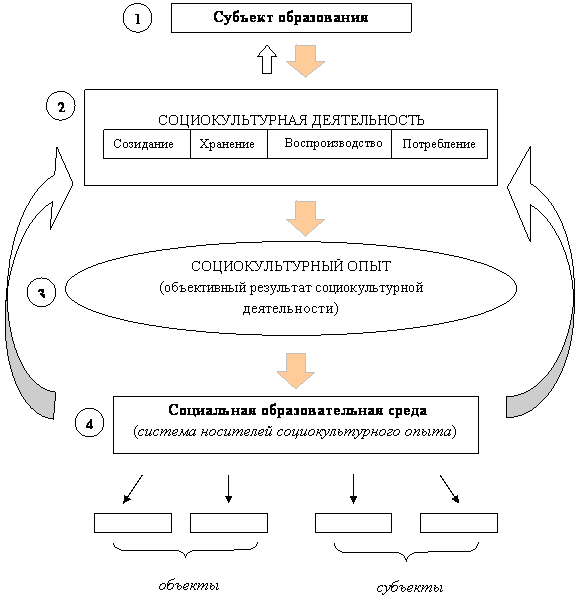
State educational institution
higher professional education
"PERM STATE PEDAGOGICAL UNIVERSITY"
Department of Multimedia Didactics and information technologies learning
Educational and methodical set of the module No. 1
on a special course
« BASICS OF PEDAGOGICAL DESIGN»
Specialty: 050203 - physics
Lecture notes
Speciality 050203 - physics
code OKSO name
Lead lecturer:
Ospennikova E.V. d.p.s. Professor
(full name, position, academic degree, academic title)
Approved at a meeting of the department
"___" _________ 2007 protocol No. _________
Permian
2007
STRUCTURE
lecture notes for training module No. 1
«MODERN CONCEPTS AND MODELS
TRAINING AS THE BASIS OF PEDAGOGICAL DESIGN (DESIGN)»
Lecture 1
The concept of "pedagogical design (design)". Theoretical approaches to design educational process
Target lectures: to state the content of the concept of "pedagogical design (design)"; give an analysis of theoretical approaches to modeling the scientific process as a stage preceding the design; demonstrate the explanatory and predictive functions of theoretical learning models of a high level of generality;
2. Theoretical approaches to modeling the scientific process as a stage of the previous design.
3.Explaining and prognostic functions of theoretical learning models of a high level of generalization.
The phrase "pedagogical design" (from the English.instructional
design
or ID ) has recently been heard and is already used in the pedagogical press. It is interesting to see how this term was formed. If we turn to the dictionary, it turns out that the word "instructional»
translated as educational, training, educational, and the word «
design»
as: 1) plan, plan, intention; 2) creative concept planning, design;
3) drawing, sketch, model, design, drawing; 4) composition, the art of composition;
5) appearance, execution, design; 6) a work of art.
In dictionary foreign words the interpretation of the word " instruction": "... an indication or set of rules that establishes the order and method of doing something," and the words " design"- "artistic design," design aesthetic appearance of an object or environment. The above translation options give us some idea of how the phrase “pedagogical design” can be understood.
Both abroad and in domestic science, this concept has several meanings. Pedagogical design (design) is considered:
· How area of pedagogical knowledge, within which development based pedagogical theories systems specifications (requirements) to create, implement and evaluate a learning environment that provides high quality teaching;
· How overall learning environment design process in accordance with the principles of didactics and the laws of the educational process;
· How process of designing educational objects and materials as components of the learning environment in accordance with the principles of didactics and the laws of the educational process;
· How academic discipline.
Instructional design as a science is a field of knowledge and research that results in detailed specifications (requirements) for developing, implementing, evaluating and maintaining situations that facilitate the study of both large and small subject blocks of all levels of complexity. This area, within which specific pedagogical actions are determined and justified to achieve the desired pedagogical results; the best pedagogical methods are researched and selected, taking into account the specific content of the course and the target audience, to bring about the desired changes in the knowledge and skills of the trainees.
Instructional design as a process: is a development based on pedagogical theories of the learning environment to ensure the high quality of teaching. This process goes all the way from analyzing needs and learning objectives to designing a teaching system to meet those needs. During the process, the composition of the types of cognitive and practical activities of students is formed, educational objects and pedagogical materials are developed to support these types of activities, the content and technologies for testing and evaluating the effectiveness of the use of objects and materials for training are developed.
Instructional design as a process can start at any time. Often the work begins with the appearance of the initial idea, which subsequently lays the foundations of the pedagogical situation. By the time the whole process is complete, the designer will analyze and check whether all the components of the "science" have been taken into account. The whole process is then described as if it had happened in a systematic way.
Instructional design represents the initial stage of systematic teaching, for which there are dozens of theoretical models. A creatively working teacher is characterized by the development author's learning model(most often found empirically). As the pedagogical process becomes more complex, especially as a result of the use of various educational technologies, including digital learning technologies, instructional design becomes more and more important.
Instructional design as an academic discipline: is a field of knowledge that studies the theory of pedagogical strategies and the process of developing and implementing these strategies in teaching.
2. Theoretical approaches to modeling the scientific process as a stage of previous design (design). Explanatory and prognostic functions of theoretical learning models of a high level of generalization.
Designing an event as a process of its detailed development is preceded by the stage of modeling - the promotion and formation of ideas about the essence of the event under study. This is the level theoretical research, putting forward ideas, forming concepts.
The basis for the development and modernization of modern learning models can be:
· works in the field of a systematic approach to the analysis of the object of study (V.G. Afanasiev, I.V. Blauberg, G.N. Serikov, E.G. Yudin, etc.);
scientific theories and concepts of the assimilation of social experience:
activity concept of A.N. Leontiev, L.S. Vygotsky and S.L. Rubinstein,
theory of formation of concepts N.A. Menchinskaya, A.V. Usova,
the theory of the phased formation of mental actions P.Ya. Galperin and N.F. Talyzina);
an informological approach to the analysis of the structure of the educational environment of learning (V.I. Bogoslovsky, V.A. Izvozchikov, E.V. Ospennikova, M.N. Potemkin);
· theoretical basis modern technology learning (developing learning technology by L.S. Vygotsky, V.V. Davydov and others, the technology of generalized skills formation by A.V. Usova, the technology of intensification of learning based on circuit and sign models educational material V.F. Shatalova and others);
competence-based approach to learning;
· the concept of practical media education (L.S. Zaznobina);
· methodological foundations and modern concepts of the development of individual independence in learning (A.A. Bobrov, V.I. Zemtsova, E.V. Ospennikova, P.I. Pidkasisty, N.A. Polovnikova, A.V. Usova,);
Methodological foundations of differentiated teaching of physics (S.V. Bublikov, I.A. Irodova, N.S. Purysheva),
· works on the methodology of pedagogical research (V.V. Kraevsky, V.S. Lednev, V.M. Polonsky, V.I. Zagvyazinsky).
The development of a learning model is a necessary stage preceding pedagogical design. If earlier the concept of designing the educational process was associated mainly with the development of its individual elements: training sessions, training materials, individual educational objects, now the tasks of integrated design of the educational process are increasingly being set. Pedagogical design on present stage has gone beyond the development of individual learning materials and is associated not only with the production of these materials, but also with the development and creation of an effective learning environment as a whole, which includes a variety of educational facilities, learning materials and learning subjects.
Let's make a distinction between the above terms.
Under learning objects we will understand the material and technical component of the educational (pedagogical) environment. These are real physical objects: objects of nature, devices, tools, models, installations, materials, technical complexes and structures, etc., which are carriers of the subject of teaching, as well as tools learning activities
TO educational materials Let's attribute the ideal component of the learning environment in the form of texts and illustrations of various types, presented in various formats and on various media (traditional, digital).
TO subjects of learning includes teachers and students, as well as other (including invited) participants educational process.
Designing the learning environment as a whole in accordance with the principles of didactics and the laws of the educational process and education of students is one of the tasks of pedagogical design.
At the stage of modeling the pedagogical environment (environment of training, development and education), which precedes the design, there are problems in choosing approaches to modeling this environment.
Exist different approaches to the analysis, research and modeling of the educational process and, accordingly, the educational environment:
· informational,
· social,
· psychological,
· pedagogical
· and etc.
These approaches make it possible to build various models of the educational process (to determine the composition of its elements, indicate their properties and functions, as well as the relationships between these elements).
Consider briefly the content of these models:
A. SOCIAL MODEL OF THE EDUCATIONAL PROCESS
Considering the educational process as social phenomenon, Can select four elements, forming its invariant structure. This:
· educational environment with its inherent forms of social activity;
· socio-cultural experience of mankind, recorded on various media;
· the personality of the individual as the bearer of social relations;
· the social activity of the individual, manifested in his behavior and activities (Fig. 1).
Each element of this model has its own properties and functions. Let us indicate the main characteristics of the model elements that determine their most important properties and functions:
1) educational environment:
· type (natural, specially organized, mixed);
· composition of carriers of socio-cultural experience;
· properties and functions of carriers;
2) sociocultural experience:
· types of experience
· the content of the experience;
3) the subject of education - a person as a carrier of social relations:
· social status,
· current level of social adaptation,
· educational claims;
4) social activity of the individual
· areas of activity,
· activities,
· the specificity of its components - subject, process, means, result.
The presented model allows us to analyze any educational process (both spontaneous and organized) and give its detailed description from the point of view of the specified elements of the model.
Modifications of the educational process arise as a result of varying the properties and functions of the elements of the model. A more complete description of the properties of the elements of the model of the educational process allows you to obtain more its possible modifications.
Focusing on the relationships between the elements of the model identified in the studies, it is possible to predict the "behavior of the system" in its new modification, i.e. evaluate its educational outcome. The structure of the model clearly indicates the multiplicity of possible educational systems.

Rice. 1. Social metamodel of the educational process
B. PSYCHOLOGICAL MODEL OF THE EDUCATIONAL PROCESS
Consider psychological metamodel educational process - its main elements, as well as their main properties. The elements of this metamodel include:
1) an individual is a subject of education, characterized by a system of components of an integral individuality:
· system of individual properties of the organism,
· system of individual mental properties,
· a system of individual socio-psychological properties;
2) mental activity of an individual, which is characterized by:
·
· the specifics of the elements of the structure of these forms - motivation, orientation, instrumental basis for performance, control and evaluation component;
· the content and level of development of mental processes that implement the leading functions of the psyche: reflection and regulation of forms of activity (sensations, perception, ideas, imagination, thinking, attention, memory, speech, will, emotions);
· type - natural, social;
· the specificity of the potential objects of his mental activity available to the individual, i.e. features of the sociocultural experience presented on any media, as well as the composition of the media,
· features of the subjects of the environment;
· ways of external support of the mental activity of the individual and the level of this support(Fig. 2).
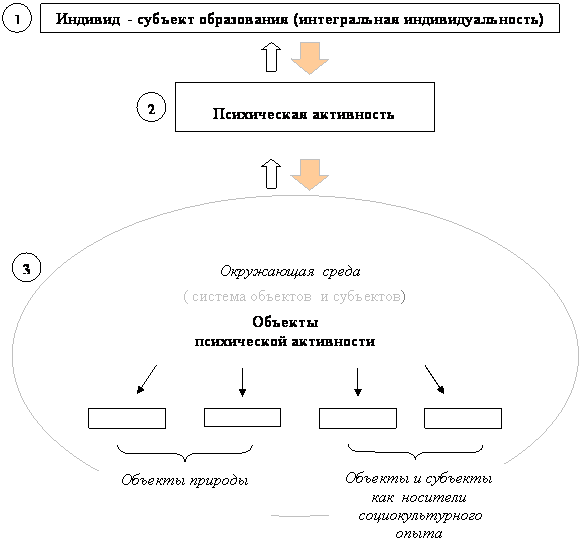
Fig.2. Psychological metamodel of the educational process
This metamodel, in contrast to the social one, also defines other areas of analysis of the educational process and allows you to build its detailed description, but from a psychological point of view.
The psychological model of the educational process cannot be directly changed. Its change is possible only through purposeful modification of the social model of education. This is the social nature of the mental. It is important to establish regular connections in these changes, i.e. identify those areas of transformation of the social model of the educational process that can cause the necessary changes in its psychological model and lead, ultimately, to other educational result.
C. PEDAGOGICAL METAMODEL OF THE EDUCATIONAL PROCESS
The pedagogical model differs little in structure from the psychological model, but has a different elemental content (Fig. 3).
1) a student is a subject of education and upbringing, characterized by a system of mastered components of social experience:
· knowledge and skills in various areas of social (out-of-school) activities,
· knowledge and skills in subject education (according to areas),
· level of ability in subject teaching and in additional education(by directions),
· individual style of subject educational activity (according to directions) and activity by interests,
· acquired values-values (humanitarian, humanistic, historical, cultural, environmental orientation)
2) student activity (in educational activities and activities in the areas of additional education), which is distinguished by:
· forms of manifestation - behavior and activity;
· the specificity of the elements of the structure of these forms - motivation ( in particular, the presence of interest in activities), orientation(ability to plan activities), instrumental basis of performance(ability to solve problems) , control and evaluation component(perform self-control of performance results);
· the content and level of development of mental processes that implement the leading functions of the psyche: reflection and regulation of forms of educational activity (sensations, perception, ideas, imagination, thinking, attention, memory, speech, will, emotions);
3) environment different:
· type - natural, social (type educational institution, type of training - basic, specialized, etc.);
· the specifics of potential objects of educational activity available to the student, i.e. features of the sociocultural experience presented on any media, as well as the composition of the media,
· the characteristics of the subjects of the environment (teachers, etc. specialists, students);
· ways of external support for learning activity and the level of this support(Fig. 3).
Social, psychological, pedagogical approaches to modeling are not new in pedagogical science. It is safe to speak about their interesting practical results that exist in the form of various models of educational systems and models of learning systems ( L.V. Zankov, D.B. Elkonin and V.V. Davydov, S.V. Rubinstein, M.I. Makhmutov, I.Ya. Lerner, V.F. Shatalov and etc.). The success of the implementation of these training systems lies in the fact that, as a rule, they model the social, psychological and didactic components of the educational process in a complex. In other words, its sequential level modeling is implemented.

Fig.3. Didactic metamodel of the educational process (generalized version)
D. INFORMATIONALMETAMODEL OF THE EDUCATIONAL PROCESS
There is a problem of finding new more general approaches to the analysis of the structure of the educational process. And this approach is informational approach.
The informological approach to the analysis of the educational process is relatively new ( IN AND. Bogoslovsky, V.A. Cabbers, E.V. Ospennikova, M.N. Potemkin and others). In relation to other approaches, it is more general. Within the framework of this approach, education is considered as a process of information interaction (“subject – object”, “subject – subject”).
Consider the structure of the information model of education (Fig. 4). The information model of education is formed by:
1) The source of information (subject or object),
2) subject - consumer of information ,
3) information exchange (subject - object, subject - subject),
4) conditions of information interaction (system of external factors influencing the process of interaction).
These components reflect information model of the process of acquiring any experience by the subject and in any form teaching, learning). Their properties and functions (initial and specially assigned) determine the result of information consumption (the quality of the assigned experience).
The information metamodel of the educational process allows you to refine the structure of models of other levels of the hierarchy ( social, psychological and pedagogical, didactic, etc..)
Possible combinations of properties and functions of the elements of the information model determine the variations of the educational process. Each of the combinations determines one or another degree of its effectiveness.
Below is a description of the properties and functions of the components of the information model of the educational process.
Properties and Functions of Information Model Components
educational process.
1. Source of information – the first element of the information metamodel of the educational process.
Each type of information source as an element of the system is characterized by certain properties and functions.
Information source properties :
· type of information carrier (biological, mechanical, optical, magnetic, electronic, etc.);
· features of the “memory” of the carrier (memory capacity, information reproduction speed, the effects of “forgetting” and “distorting” information, etc.);
· content content:
type of information
amount of information ;
method of presenting information on a medium
search methods;
· information activity (active, potentially active, reactive);
· communication channels that provide interaction with the consumer of information (perceptive, verbal, etc.).
Information source functions :
· storage of information, determined by the volume and characteristics of the memory of its carrier;
· accumulation of information;
· transformation of information (for example, its formal-logical processing, semantic, value, etc.);
· interaction with potential consumers of information (providing information "output" - the transfer of information, the implementation of feedback from the consumer - the presence of management functions and their change in connection with the characteristics and result of information consumption).
Any person, one way or another, interacts with sources of information. The choice of the source, the activity of interaction and the methods of this interaction are determined both by the properties and functions of the source, and by the characteristics of the consumer.
Society actively influences the system of existing sources of information. The system of artificially created sources is constantly being improved: their properties and functions are developing in accordance with the needs of users.
2. The subject as a consumer of information - the second element of the information metamodel of the educational process.
Properties of the subject as a consumer of information :
· available channels of communication with the source of information (perceptual, verbal, mixed);
· memory (the volume of actual and long-term memory, the speed of information reproduction, the speed of "forgetting", the presence of effects of "distortion" of information, etc.);
· information activity:
direction of activity
the level of activity associated with the characteristics of the biological, mental and social nature of the subject (bioenergetic security of activity, the perfection of the processes of reflection and regulation as functions of the psyche of the subject, the ideal "tool" equipment of the consumption process - ZUNs and SUDs, the level of motivation, awareness of the personal and social meaning of the subject and activity process, etc.).
Functions of the subject as a consumer of information :
· interaction with information sources: its perception (reflection), self-regulation of the consumption process;
· accumulation of information;
· semantic processing of information, building in the mind of the subject of its ideal image, embedding this image into a holistic individual "image of the world".
· data storage;
3. Interaction of the subject with the source of information - the third element of the information metamodel of the educational process.
This is a procedural element of the system. Its existence is possible due to the presence communication channel between the consumer and the source of information. Interaction is represented by specific forms of activity of the subject (behavior and activity) and its types in various areas of human development. environment, as well as forms of activity of information sources .
The qualitative characteristics of interaction are :
· types of information activity of the subject, corresponding to the nature of the source of information and the methods of its transmission embedded in this source (in other words, the methods of presenting information specific to this source, and the associated methods of its consumption by the subject);
· the content of the material "tool" equipment of information consumption (composition of material means of consumption - tools of knowledge and practical work);
· mode of interaction (external control of the process of information consumption and its methods or self-government and its methods).
Functions of the "channel" of information exchange:
· information transfer (channel capacity, transfer rate),
· providing feedback - the impact of the result of the process on its course and (and) the impact of the result of the process on the governing body (type of connection: positive, negative; efficiency of communication),
· exclusion of distortions that affect the processes of perception and comprehension of information in the process of its transmission.
4. External factors influencing the process of information exchange, – the fourth element of the information metamodel of the educational process .
Their composition is determined by the objective and subjective conditions of information consumption. These conditions include objects and subjects of the environment, which are not directly involved in the process of information interaction, but have an impact on this process. Features of the environment environment, its properties and functions are very diverse. Its influence can lead to changes in the interaction characteristics and modify the operation of the communication channel. The subjects and objects of the environment can influence not only the process of interaction itself, but also the properties and functions of both the source and the consumer of information.
External influence can be both spontaneous and organized. Organized external influence leads to a purposeful change in the result of information consumption in terms of its quality, as well as the effectiveness of the process of obtaining this result.
The external impact on the process of information consumption can be described using a series characteristics:
· direction of influence (on the source of information, on the communication channel, on the consumer of information),
· mode of action ,
· impact intensity ,
· mode and duration of exposure .
The system of elements of the information model, the totality of their properties and functions, shows us the direction of the search for more advanced educational systems in terms of the quality of the information exchange that is implemented in them. The modeling process within the framework of the informological approach can be of a formal-logical nature. Subsequently, a meaningful understanding of the chosen modification is necessary: its assessment in social, psychological terms. final stage research is a pedagogical experiment.
The breadth of the range of directions for modeling the educational process based on its information model shows us its predictive functions. But on the basis of the information model, an analysis can be carried out and an appropriate assessment of existing educational systems can be given. (explaining function).
In the structure of the information model of the educational process, two most common components can be distinguished.
Let us define as the first component of the subject - information consumer. The second component is formed by the 1st, 3rd and 4th elements of the information model (see Fig. 1, fill selection). These elements form information and educational environment in which the subject of education is immersed.
Information and educational environment (IOS) is defined as a system of information sources available to the consumer, objectified methods and means of its appropriation, as well as the conditions for the subject's information interaction with these sources.
The specificity of the information and educational environment is determined by the qualitative composition of its elements, as well as their properties and functions. Combinations of these elements, a variety of properties and functions of the latter give rise to various modifications of the information and educational environment (IEE) (see.information model of the educational process).
The content of the educational process is determined primarily by the composition and content sources of information information and educational environment (Fig. 5). There are many of them, but, nevertheless, the entire set of information sources can be divided into a limited number of fairly homogeneous groups. According to these groups of information sources in the information and educational environment, the following relatively independent information and educational environments-components can be distinguished:
· natural nature ;
· "second" nature ("man-made" objects, tools of varying complexity and scale);
· communication environment (Wednesday social communication individuals);
· traditional information funds (printed word, audio and video);
· virtual information environment (reproduces or models all known sources of information);
· game environment(conditional combination of game components of various environments).
The ways of human interaction with sources of information in each environment are specific and are the subject of purposeful development. These are the ways:
a) consumption and processing of primary information, the source of which is nature;
b) ways of obtaining "ready" information from its "universal stores".
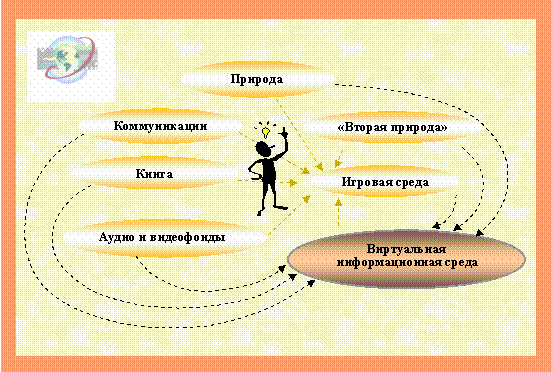 |
Rice. 5. The system of information sources of the learning environment
3. Explanatory and predictive functions of theoretical learning models of a high level of generalization.
So, it is possible to model the educational process in social, psychological, pedagogical, informational and other plans. These approaches differ in the degree of generality and, therefore, we can talk about the levels of modeling corresponding to them. You can arrange them in order of degree of generality: informational, social, psychological, pedagogical.
Knowing the composition and main characteristics of the elements of each model, it is possible to search for its various modifications. A preliminary assessment of their educational effect is possible in the form educational hypotheses. The very process of improving the educational system can be defined as a sequence of more effective modifications of its social, psychological, pedagogical and informational metamodels in relation to the educational result.
Construction and preliminary evaluation of models of the designed educational process, adjustment of existing projects based on the above structural components metamodels of various types are important areas for improving the quality of the results of pedagogical modeling and subsequent design.
The system of elements of the metamodel, the totality of their properties and functions shows us the direction of the search for more advanced educational systems in terms of quality information exchange, social and psychological-pedagogical interaction that are implemented in them.
Let's try for an example using the above information metamodel educational process, to determine the most promising directions for the development of the system of modern mass education.
New more advanced modifications of the educational process in terms of its informational basis can be related to:
· with the analysis included in the information educational environment sources of information and determining their optimal combination (weight ratio) in an organized educational process (see Fig. 6);
· improving the ways of information content of sources:
by type of information (meanings and meanings of individual, meanings and values of social consciousness);
Byvolume yinformation;
according to the content of information (composition and content of meanings, meanings and values);
by the way information is presented on the media : coding language (natural, artificial), method and principles of structuring (systematization), methods of reproduction (static, dynamic);
by search method;
· search for each type of information, as well as its specific content, for the most effective carriers in terms of the learning effect (see Fig. 6) or their optimal combination in the structure of the information learning environment;
· increasing the level of activity of sources-objects of information (books, audio and video funds, "second nature", virtual environment) by expanding and improving their properties and functions, in particular:
ways of presenting on media and methods of its operational search;
implementation and improvement of customer feedback functions:
- development of the information consumption management function and its operational changes based on the results of activities,
- improvement of the didactic apparatus built into the source to stimulate and support information consumption,
- development of didactic applications to the source of information, in which they are objectified (presented in the form of samples) rational ways its consumption;
· the development of material means (tools) of information consumption, corresponding to individual sources of educational information;
· expanding the range of methods of interaction between students and the sources of educational information involved in the information environment and the development of these methods of information interaction by students;
· full use of the information capabilities of existing educational information carriers (their properties and functions), in particular, the information capabilities of computers;
· technical improvement of the existing carriers of educational information and communication channels with its students and, finally, the creation of new types of carriers of educational information.
Some of these areas of development of the system of modern education are being actively developed at the present time. This circumstance demonstrates to us the explanatory potential of the proposed informational metamodel of the educational process.
An analysis of the information metamodel of pedagogical systems and technologies that have won recognition shows that all of them, declared as alternatives to traditional learning, implement a single principle of searching for a new educational idea. It's a principle hyperbolization of functions any one (rarely two) sources of information of the educational environment, as well as individual ways of work of students with sources of educational information.
So, for example, when problem learning the focus is on educational research organization objects and processes of natural nature. However, the very idea of problem-based learning involves the search work of students not only with natural phenomena, but also with the sources of socio-cultural experience already acquired by mankind (books, video recordings, computers, etc.). In this case, we are talking about the development of students' ability to independently identify the most rational ways of information consumption of information fixed on the source. The problem of educational activity in such a situation lies in the search for methods specific for these sources of information to extract it.
As part of pedagogical system of "developing education" D.B. Elkonin - V.V. Davydov the focus is not just on the process independent research (search). Mastering the subject is mainly related to the implementation deductive method of consumption of semantic information(from general theoretical knowledge to specific phenomena). The independent finding of the general in the individual is not excluded, but is most consistently realized in system of developing education L.V. Zankov .
CSR technology - collective way of learning- based on active work of schoolchildren with educational texts and a source of information such as educational communications, and the main link in the field of educational communications is the students themselves (V.K. Dyachenko).
The main way of information consumption in design technology act academic research(mainly applied orientation, the main source of information is natural nature and society, “second nature”).
Traditional learning associated with the hyperbolization of the function teachers as a source of educational information. Of course, the work of students with other sources of sociocultural experience is to some extent represented in the traditional school. Nevertheless, the main efforts of pedagogical science for many decades of the last century were aimed at improving the methods of "transmission" of sociocultural experience by the teacher. A private methodology was actively developed, a system of visual support for the presentation of material by the teacher ( technical base and didactics of visual aids).
The educational effect of the above teaching technologies must be correctly interpreted. It only allows one to assess the degreethe influence of various sources of information and used in pedagogical experiment individual ways of working with them on a specific educational result.
Hyperbolization of the functions of individual sources of information cannot serve as the basis for the harmonious development of students in terms of mastering the basics of socio-cultural experience.
The informational approach to the analysis of the effectiveness of various educational technologies shows that each of them includes information reserves not yet involved in educational practice. Therefore, in our opinion, it is premature to make a final conclusion about the comparative effectiveness of technologies based on the use of various sources of information.
Taking into account the objective differences in the properties and functions of subjects as consumers of educational information, one should a priori state the effect of personification of the technologies of their work. In other words, in the information and educational environment, as the trainee accumulates experience in working with educational information, the processes of formation of individual integral technology of information consumption. This effect should certainly be taken into account in educational practice.
The process of personification of information consumption technology - formation of an individual style of information consumption- will fully correspond to the individuality of the subject only if he is trained in a wide information and educational environment and in this environment the subject has free access to all types of information sources.
The development of teaching technologies related to the organization of the work of schoolchildren with individual sources of information is a serious contribution to pedagogical science. The next stage in the development of pedagogical knowledge is, in our opinion, a meaningful and procedural synthesis of these technologies and the search for ways of their organic interaction in the information and educational environment. Its construction should be based on an optimal system of information sources.
The traditional education system and alternatives to it educational systems in the process of their analysis, differences are found not only in the pedagogical, but also in the informational, and in the social, and in the psychological planes. A version of the systemic description of the specifics of these educational systems is presented in the works of G.K. Selevko. The above social, psychological, pedagogical and informational metamodels of the educational process make it possible to clarify the directions of system analysis of the essence of these education systems.
When analyzing teaching technologies in relation to the educational process in physics, it is advisable to refer to the currently known system of types of educational activities of schoolchildren in the subject (see. Annex 1).
Questions for self-control
1. Interpretation of the concept of "pedagogical design".
2. The concept of "information and educational environment". The main sources of educational information of the learning environment.
3. Definition of the concepts of "learning objects" and "learning materials of the learning environment.
4. Approaches to modeling the educational process in pedagogical science.
5. Metamodels of the educational process and their characteristics.
6. Explanatory and prognostic functions of theoretical learning models of a high level of generalization (on the example of the most famous pedagogical models and learning technologies).
1. Using Internet information sources, select materials on the interpretation of the concept of "pedagogical design". Draw up a table that includes the following sections: definition of the concept, author, source of information. When preparing the table, systematize the found definitions according to their content. Analyze the results of the work to formulate conclusions. Prepare a presentation for oral presentation of the results of independent work on the assignment.
2. Prepare a written review of the content of 3-4 educational technologies. Analyze each of the technologies in terms of learning metamodels. To give a comparative description of the learning models corresponding to these educational technologies in informological, social, psychological and didactic contexts.
1. Appendix 1 to the lecture.
2.Digital version of the lecture in the DO "Moodle" system.
Lecture 2 Fundamentals of the theory of modeling the educational process
Purpose of the lecture: set out the principles of modeling the educational process, consider the levels of modeling; to analyze the content of the concepts of "learning technology" and "pedagogical design" from the standpoint of the theory of modeling and designing the educational process.
Issues discussed at the lecture
1.Principles of modeling the educational process.
2.Levels of modeling the educational process
3. The concept of "learning technology" and "pedagogical design" in the theory of modeling and designing the educational process.
1. Principles of modeling the educational process.
Multidimensional (or level) modeling of the educational process enhances its explanatory and prognostic functions.
Let's define principles of modeling an organized educational process ( pedagogical process) based information metamodel education:
1. Modeling the educational process is nothing more than building its three-dimensional ( informational, social, psychological) metamodel. Such an approach to the process of modeling the educational process provides, as a result, the educational model that is most adequate to its essence and target orientation ( the principle of multiple descriptions of the educational system).
2. Informological approach to the study of the educational process in relation to social and psychological approaches is more general due to the high level of abstraction of the analysis of the essence of learning as a process of information interaction (“subject – object”, “subject – subject”). Universal components of the information metamodel ( source of information, the subject of the study as its consumer, information interaction "source - consumer" and the conditions of information consumption) characterize the process of acquisition by the subject of any experience, including the experience of learning. Their properties and functions determine the result of information interaction - quality of experience.
Building social and psychological metamodels of the educational process is the content of the blocks informational metamodel corresponding to: the social nature of education, the nature of the human psyche, the characteristics of his social status and mental development (the principle of consistency in determining the metastructure of the modeling object).
3. The information model of an organized educational process, according to its characteristic features, must correspond to the information model of the environment and, as a result, ensure a conflict-free transition of the subject from the artificial educational system to the natural educational environment of life. In this regard, the weight ratio of information sources of the artificial learning environment, the methods of working with these sources involved in it, the quality of the fundamental component of sociocultural experience presented on the information carriers are important. These characteristics of the informational metamodel of organized education subsequently ensure the effectiveness of the processes of social adaptation and integration of the individual into society. Modeling of an artificial information and educational environment should be carried out not only in accordance with the properties and functions of the natural information environment of education, but also provide for active interaction artificial environment with a natural information and educational environment, take into account the processes of their mutual influence Each other ( principles of conformity and openness in information modeling of artificial educational systems).
4. The modifications of the information metamodel of the educational process obtained as a result of modeling must be subjected to a deep meaningful analysis in terms of their social value and psychological expediency. It is important to know what changes in connection with the updating of the information model of the educational process can occur, respectively, in its social and psychological spheres ( principles of causality and unity of nature of the modeling object).
5. Modeling has a level character:
§ modeling of the composition of metaelements and relationships between them - macro level,
§ modeling the structure of metaelements as relatively autonomous entities – mesolevel,
§ modeling of the components of the structure of mesoelements - microlevel) (Fig. 1).

Rice. 1
The depth and completeness of level modeling are determined by the objectives of the study. Modifications can be reduced to changing only individual elements of the metamodel at any of its levels. Any change made to the metamodel must be subjected to level analysis. Transformations in the structure and properties of the elements of the metamodel lead to a change in its integral functions. Evaluation needed integral consequences changes embedded in the informational, social and psychological models, at whatever level of modeling and to what extent these changes are made ( principles of structural and functional division of an object into its constituent elements and the structural integrity of the phenomenon, which determines its integral properties)
6. The initial element of modeling is the subject of education - the consumer of information. Its psychological, social and informational models of functioning and development ( meso- and microlevels of modeling) determine the directions for the development of all other elements of the education model ( principles of "natural conformity" and student-centered learning).
7. Not only the processes of functioning of the educational system are modeled, but also the processes of its development. The model of the educational process should assume ( or reflect) the effects of continuous and consistent improvement of the subject of education. The model of education should include the directions of "evolution" this process that provide him with the desired informational, social and psychological"exit".
Modeling is carried out in accordance with the laws of the development of the child's personality known in science. The most important direction in the development of specially created educational systems is the direction associated with the processes of approximation of the properties of these systems to the properties of the natural information environment of personality education. This "rapprochement" is provided as pupils grow up by a regulated change in the activity of the organized education environment: from active to potentially active and passive information learning environments ( principles of continuity and succession of the development of the object of modeling).
8. Projected modifications of the metamodel of the educational process are predictive in nature. The educational value of modification should have a detailed philosophical and socio-psychological justification. The model of the educational system can be developed as a consequence of the relevant philosophical concepts, socio-psychological theories of personality and activity.
Pedagogical modeling can be both formal-logical and heuristic in nature. With any approach to modeling, the expected effect of the practical implementation of the developed model of the educational process is probabilistic in nature and obeys the laws of statistics ( the principle of probability of the projected effect of the model of the educational system).
9. The actual educational process and the designed educational system must be checked for compliance. The construction of a multilevel model of the educational process provides a higher level of reliability of its model description. The basis for assessing the accuracy of the model description is the explanatory and predictive functions of the model. An adequate educational model makes it possible to consistently describe the pedagogical reality; the educational effects predicted on its basis are, as a rule, confirmed in a pedagogical experiment ( the principle of reliability of the model description of the educational system).
2. Levels of modeling the educational process.
The most important principles of modeling are the principles of the structural and functional division of an object into its constituent elements and the structural integrity of the phenomenon, which determines its integral properties.
The development of a model of the educational process includes:
1) identification of the composition and "fine" structure of the elements of the metamodel ( meso- and microlevels of modeling) (Fig. 1);
2) determination of the completeness and depth of the analysis of its elements in accordance with the tasks and the general strategy of modeling;
3) "normalization" of the content of the metamodel elements in accordance with:
· with the initial characteristics of the simulation object;
· with their proposed changes, taking into account the social order and the peculiarities of the mental development of the social group of students that is included in this educational process.
A multi-level model of the educational process allows the researcher to understand the essential features of the object of modeling and outline the key directions for their qualitative transformation in order to obtain the projected educational effect.
System-structural approach to the process of modeling the educational process, strict adherence to the typology of modeling ( informational, social, psychological And pedagogical plans), as well as modeling levels ( macro, meso and micro levels) allow you to build a specific didactic metamodel of the organized educational process(Fig. 2). Its composition is formed by the following elements:
1) learning content as a normative part of the adapted socio-cultural experience;
2) source system learning content, teacher as an active subjective principle in the system of sources of sociocultural experience,
3) student as an active subject of the learning process;
4) learning as a two-way process, implemented on the basis of the use methods and means of teaching, methods and means of teaching;
5) external conditions for the course of the educational process(number of participants, place of occurrence, its logistics);
6) form of organization of educational activities, reflecting the mode of additional subject-subject and subject-object relations in the interaction of the student with information sources (as a consequence external conditions of interaction);
7) form of organization of the lesson- a time-limited stage of the educational process, - reflecting a system of stable links between its elements.
These elements form a didactic model macro level(Fig. 2) the didactic model can be considered as a component of the pedagogical model. Its second component is the model of education. However, such a division of the processes of education and upbringing in the pedagogical model is artificial. These processes are inextricably linked. The formation of values-values (the result of education) is carried out only on the basis of enrichment and generalization of the socio-cultural experience of the pupil (ie, on the basis of organized training or learning).
Mesolevelmodeling the didactic process involves identifying the structure of macroelements. Here is the composition of the generalized didactic models of the mesolevel of modeling:
1) learning content model (model of the subject matter);
2) model of the system of sources of adapted socio-cultural experience in the school information and educational environment;
3)student model, as a carrier of sociocultural experience ( at the initial stage of training and by the end of the training period);
4)teacher model as a carrier of sociocultural experience in a given subject area and experience professional activity on the organization of the educational process ( possession of methods and means of teaching, forms of organization of the educational process);
5) model of the system of teaching methods, including models of the system of didactic means (teaching aids, teaching aids) and teaching methods;
6)model of the system of forms of organization of training sessions.
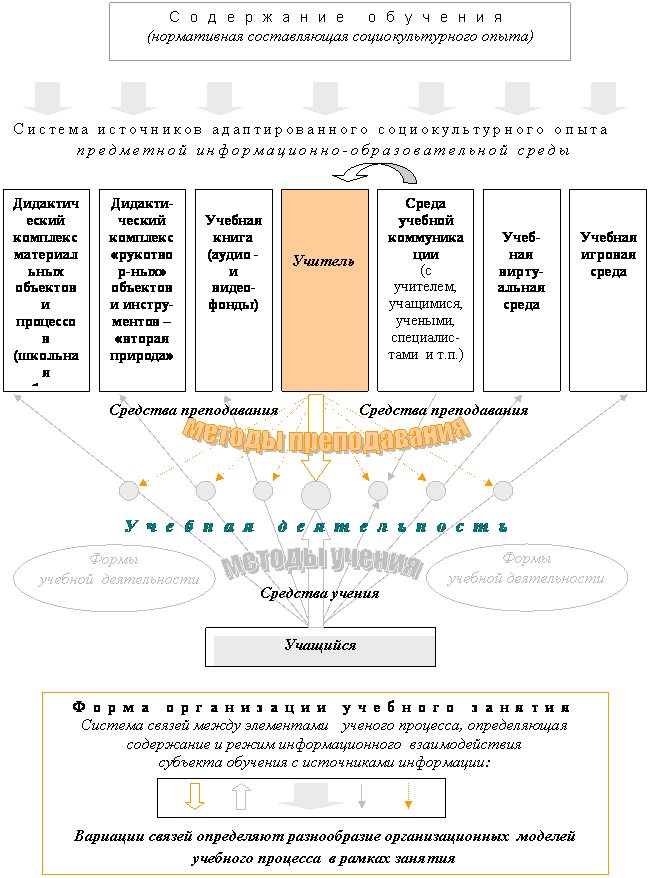
Fig.2. Didactic metamodel of the educational process
(specified version)
It is possible to pose the problem of modeling the educational process at the micro level. In particular, micro-level models of modeling include models of individual teaching methods, model of the training session and models of specific organizational forms of construction of training sessions, etc. There are models of individual elements of the lesson, for example, the model systems of educational objectives of the lesson, model didactic structure of the lesson etc.
The development of a generalized model of the educational process based on level modeling seems to be a very productive direction in pedagogical research. This approach is gaining attention in pedagogical research and the recognition of practicing teachers. The generalized didactic model of the educational process allows:
1) create a holistic image of the educational process, based on understanding the composition of its elements and the relationships between them; carry out its purposeful and systemic adjustment as pedagogical theory and practice develop ( clarification of the composition, properties and functions of the elements of the model, relationships between them, deep differentiation of the "fine" structure of individual elements, etc..);
2) to understand the main directions of modification of the learning process associated with a controlled change in the properties and functions of its elements in accordance with the goals of learning; ultimately reduce the effects of spontaneity in the design and practical organization of educational activities of young people;
3) to determine the generalized procedures for modeling the educational process at its meso- and micro-levels, in particular:
· objectification of new elements of the content of education, the search for new methods and organizational forms of education, etc. -mesolevel modeling,
· formulation of the objectives of the lesson, the choice of methods and techniques of teaching in the classroom, the construction of their specific procedural and operational scheme, preparation for the lesson of didactic means of various target orientations, the definition of a rational organizational form training for a specific training session, the development of a project for a separate lesson within a specific organizational form of training, etc. -microlevel modeling;
4) provide effective modeling of procedural elements of various modifications didactic model – individual teaching methods or some system of them, which will allow, based on the construction of their generalized and specific procedural and operational schemes, to pose and rationally solve the problem of developing appropriate learning technologies ( creation of generalized models of learning technologies).
When developing a didactic model of subject education, it is necessary to focus on the system of types of educational activities in physics, the system of teaching methods and techniques and the system of forms for organizing training sessions on the subject and forms of educational activities, the system of teaching aids (see.applications 1-6).
The method of modeling the educational process is actively used in modern pedagogical research. As a rule, modeling of individual elements of the educational process is carried out. More and more obviously, the subject of scientific research is an integrated approach to solving this problem (A.I. Arkhipova, V.V. Guzeev, A.A. Mashinyan, V.V. Monakhov, E.V. Ospennikova, V.E. Steinberg and etc.).
3. The concept of "learning technology" in the theory of modeling and designing the educational process.
Pedagogy (the science of educating and educating the younger generation) has long been rightly considered an empirical science. In the second half of the 20th century, the transition to the theoretical stage of its development was clearly marked. Theoretization of pedagogical science is connected with the strengthening and expansion of its relationship with the leading psychological theories of personality formation, the formation of its main qualities and mental functions.
Previously, pedagogical knowledge developed relatively independently. This development followed the path of systematization and generalization of the wide practice of teaching and, above all, advanced pedagogical experience. The result of this generalization was the principles of education and training.
In terms of their content, the principles of pedagogy represent the most general empirically identified laws for organizing the education and upbringing of young people. These regularities are quite clearly formulated in didactics. The fundamental principles of education are the principles consciousness and activity, visibility, systematicity and consistency, strength, scientific character and accessibility, connection between theory and practice and others. The composition of the principles of didactics is periodically expanded. In pedagogical science, certain principles of teaching correspond to well-defined rules of teaching (i.e. proven by pedagogical experiments are the consequences of the principles of didactics as general patterns learning)
Compliance with the patterns represented by the content of the principles of didactics and the rules for their implementation ensures the effectiveness of the pedagogical process.
The educational process, built on the basis of the principles and rules of education, being generally organized and productive, remains to a large extent still a spontaneous process and, most importantly, is too much "tied" to the personality of the practicing teacher, who largely gives his own practical interpretation of the principles. and teaching rules.
In order to reduce the effect of the spontaneity of learning and the significant dependence of its effectiveness on the personality of the teacher, in the last three decades, the system of principles and rules of teaching began to be transformed ( transform) into a system of uniquely defined training procedures, rigidly linked to each other. The procedural description of the educational process was fixed in a set of didactic materials that support these procedural actions of the teacher ( educational materials for students, models of training sessions for the teacher and a strictly defined set of visual aids that support these classes).
Subsequently, this led to the development of a whole area of pedagogical research related to the "technologization" of education. Pedagogical technologies have entered pedagogical science.
Learning technology - this is a project of pedagogical activity, including a description of the initial state of the subject of learning, a set of methods and means of teaching influence, procedural and operational models of learning activities, the result of learning (the end state of the subject of learning), as well as time intervals for achieving the projected result, indicating the "scatter boundaries" of effectiveness training in the conditions of practical implementation of this project in given conditions.
The first teaching technologies were essentially empirical in nature, many of them are still very effective.
Modern psychology provides an explanation for almost all empirically found regularities in the construction of the educational process (principles of didactics). From the point of view of its subject, the effectiveness of proven empirical technologies is quite understandable.
Experimental research in the field of psychology, the processes of formation of theoretical psychological knowledge led to the development of psychological theories (theories of perception, theories of assimilation, learning, memory, theories of personality formation, etc.). Psychological theories, in comparison with pedagogical principles, constituted a fundamentally different basis for the development of technologies for teaching and educating young people. Teaching procedures incorporated into pedagogical technology are based not only on the generalization of advanced pedagogical experience, but also on the psychological patterns of the learning process identified in the experiment, as well as on model ideas about the essence of the processes of perception and assimilation of information, its preservation in the student’s memory, theoretical concepts of development higher mental functions, etc. Obviously, the use of such technologies in educational practice is more effective, since their procedural elements are less related to the personality of an individual teacher and the personality of a particular student. The effect of applying theoretically “engineered” technologies is, of course, more stable.
The theoretical approach to the development of teaching technology allows not only to explain the set of empirically found rules for constructing the educational process, but also to clarify in principle the composition of these rules that is necessary and sufficient to obtain the appropriate educational effect.
The processes of formation of pedagogical technologies (empirical, theoretical) are shown in fig. 3. Modern trends in the technologization of the educational process as a way to reduce its spontaneity and improve performance are associated with the development of theoretically based pedagogical technologies. Such technologies include problem learning(the concept of thinking by S.L. Rubinshtein as an essentially productive process leading to new knowledge), programmed learning technology(a combination of psychological theories of learning and cybernetic approaches to managing the learning process, N.F. Talyzina, P.Ya. Galperin), developmental learning technologies L.V. Zankova, D.B. Elkonin and V.V. Davydov (the psychological concept of learning by L.S. Vygotsky, the theory of activity by A.N. Leontiev, psychological studies of the patterns of generalization processes by V.V. Davydov, P.Ya. Galperin), etc.
It should be noted that at present, not all productive psychological and pedagogical concepts of education have been brought to the level of technology. The development process very often lingers at the level of describing the teaching methodology and individual technological blocks of educational or educational work. The development of technology often falls entirely on the shoulders of the teacher, who cannot always cope with this complex and time-consuming task and unconsciously allows the distortion of certain elements of the model and teaching methods in the technological procedures developed by him.
Teaching technologies based on the psychological and pedagogical concepts of learning and personal development are not only more resistant to changing teachers, but also able to withstand quite serious structural and content changes in the field of education as a whole. In this sense, theoretically substantiated pedagogical technologies constitute a relatively stable part of the young generation training system. Empirical technologies are very dependent on their contemporary educational paradigm ( set of implicitly specified regulatory principles). The provisions of the educational paradigm, which operates at each stage of the development of society, have a significant impact on the composition and content of the rules of education and upbringing formulated within the framework of empirical technology. Empirical learning rules found and regulative educational settings, as a consequence of the paradigm, are very often intertwined and hardly distinguishable in empirical pedagogical technologies.
An empirical approach to the construction of learning technology reflects the ways of learning found in pedagogical practice. Effective individually, they, as a rule, do not form a system necessary and sufficient for effective learning. Their composition, hierarchy is not always clear ( relative importance), the proposed sequence of application.
Technologies based on theoretical views are less connected with the current educational paradigm and more resistant to its change. The content of the teacher's work methodology ( directions and rules of work) is more universal in this case. Compound guidelines covers, as a rule, all aspects of the organization of the educational process and is a description of the teacher's work system.
The success of the development of theoretical technologies depends on the accuracy of the pedagogical interpretation of the consequences of the psychological theories that have received experimental substantiation, the correspondence of the pedagogical model of teaching to the essence of the psychological theory underlying it.
Any technology is defined through the description of its three components:
- object of influence,
- systems of means and methods of working with a given object in order to obtain a product of a given quality, and, finally,
- subject of influence (see Fig. 3)

Rice. 3 . Ways of formation of pedagogical technologies
Technology Coreconstitutes a system of means and methods of working with a given object in order to obtain a product of a given quality. When transferred to the educational environment, this is a system of means and methods for organizing the educational process (influencing the personality of the student). The system of methods of influence in the development of technology must receive a strict procedural and operational description in order to be reproduced by another teacher, and the system of means of influence must be represented by educational objects and educational materials prepared in accordance with the learning model for organizing various types of student activities. The composition of educational objects and materials is determined by the system of types of educational activities implemented within the framework of a specific learning model (see Appendix 1), and together gives us an idea of the content of the learning environment.
Consider a generalized model of learning technology. The structure of the model includes:
Description of the target group of students (level of education, type of education (general education or profile), special educational needs, quantitative composition of the group).
Teacher Qualification Requirements (level of education, specialization).
Learning Model (general characteristics, scientific justification).
Learning objectives, development, education.
Learning objectives(Expected results)
Sources of educational information used by students in teaching.
Types of learning activities with sources of information.
Teaching methods(composition and general characteristics), including methods for monitoring and evaluating educational achievements.
Types of learning tasks for students, a general description of the system of educational tasks.
Learning Tools System (list of educational objects and educational materials, their general characteristics, software for distance learning, testing software, etc.).
Educational materials (textbooks, teaching aids, workbooks, handouts didactic material, digital benefits for CD , content for distance learning, testing complexes, etc.).
Thematic planning indicating the forms of training sessions.
Educational-methodical complexes of classes.
Educational-methodical complex (EMC) classes
(invariant structure)
1. Topic of the lesson
2. Form of the lesson
3. Class, profile, specifics of training
4. Goals:
· learning,
· education,
· development.
5. Learning objectives of the lesson.
6. Didactic structure of the lesson.
7. Diagnostics of the effectiveness of training in the classroom.
8. Draft content and whiteboard writing (or presentation MS PP to the lesson) and in the student's notebook.
9. Didactic tools:
· demonstration experiment (purpose, equipment, including computer hardware);
· frontal laboratory experiment, frontal observations (target, equipment, including computer hardware);
· models of technical applications of physical science (machines, installations, tools, etc. or their models);
· audio and video recordings (title of the recording or its fragment);
· wall-printed visualization (tables, diagrams, graphs, OK, etc.);
· computer software (subject DER, IUMK, IISS on CD, resources for distance learning);
· game objects;
· didactic handout for independent work of students;
· literature and digital sources of information for students (basic, additional);
· system of means of TSO.
10. Abstract of the lesson.
11. Literature for the teacher.
The description of the learning technology in accordance with this model ensures the reproducibility of the educational process by another teacher (i.e., mass application practice is possible) and, accordingly, the achievement of predicted learning outcomes within the expected data scatter limits.
In conclusion, let us consider the relationship between the concepts of "pedagogical technology" and "pedagogical design". If pedagogical technology can be defined as a ready-made project of pedagogical activity, in which a detailed description of its components is given and developed educational objects and materials are presented, then pedagogical design is the actual process of designing (creating technology) in accordance with the original concept and learning model. Educational design is also a system of specifications (requirements) for the development of this technology.
The development of pedagogical technology is an extremely time-consuming and multi-professional activity. It requires the experience of a subject teacher, methodologist, psychologist, educator, artist, in some cases a screenwriter, programmer (for digital resources), as well as other specialists.
Previously, the authors of technologies were (and are now) mainly methodologists and teachers practicing in the field of education. Being great enthusiasts of their work, they created new educational devices, printed didactic handouts (didactic cards for independent work, reference notes, workbooks, instructions, creative building systems of various types, etc.).
It should be noted that informatization of the educational process gives a powerful impetus to the development of various learning technologies. In a virtual environment, the pedagogical concept, model and teaching methods can be more successfully implemented in the form of educational technologies, since the functionality of the virtual environment itself is focused on the definition of specific educational procedures. There are two ways to implement learning technologies:
1) the teacher, using the proposed system of educational objects and materials (traditional, digital) as some initial technological training base and relying on the model and provisions of the teaching methodology, independently builds a system of teaching procedures; the virtual environment acts in this case as part of the learning environment; with this approach, as a rule, there are many author's variations of the initially given learning model;
2) the teacher transfers the main functions of the organization of learning to the computer: learning is carried out in a virtual information environment based on digital educational objects and materials (at the same time, it is possible to refer to traditional objects and materials, but on the instructions of a “virtual teacher”); the structure of the virtual environment and the ways of its interaction with the user contain a system of training procedures that uniquely corresponds to the original learning model; the task of the teacher is to coordinate the transition of the student from one virtual learning system to another.
The virtual learning environment, in terms of its functionality, can quite fully and unambiguously implement the model and the corresponding learning technology. Everything depends on how fully the educational objects and materials are presented in this environment, what is their quality, how competently the activities of students with the components of the virtual environment are defined. By increasing the accuracy (rigor) of the execution of the main and auxiliary procedures of the learning technology, the virtual environment also provides a more stable educational effect of this technology in its mass application.
In the context of the growing scope of the use of the virtual information environment in the educational process, the responsibility for the quality of its filling with educational information and the quality of its inactive properties is growing. This responsibility lies not only with large professional teams of authors who create digital learning resources, but also with teachers who, one way or another, are faced with the need to independently design the components of a virtual learning environment.
Now, in the conditions of informatization of education, teachers are able to create only technologically simple teaching materials. Nevertheless, the initial knowledge of pedagogical design (design) is absolutely necessary for them. This will allow the teacher to expand the range of tasks for developing the components of the author's pedagogical technology and solve even simple, but important design tasks for professional activity.
Questions for self-control
1. Principles of modeling the educational process.
2. Levels of modeling the educational process.
3. Didactic model of the educational process (macromodel).
4. Model of the system of teaching methods (for natural sciences)
5. Model of the system of forms of organization of training sessions (for natural science disciplines).
6. Model of the system of forms of educational work.
7. Model of the system of teaching aids in physics.
8. Meso- and micro-level of modeling in the construction of a didactic model of the educational process.
9. The concept of "pedagogical technology".
10. Components of pedagogical technology.
11. A generalized model for describing learning technology.
12. Types of pedagogical technologies and their characteristics. Examples of pedagogical technologies.
13. Correlation between the concepts of "learning technology" and "pedagogical design".
Tasks for independent work
1. Using Internet information sources, select materials on the interpretation of the concept of "pedagogical technology". Draw up a table that includes the following sections: definition of the concept, author, source of information. When preparing the table, systematize the found definitions according to their content. Analyze the results of the work to formulate conclusions. Prepare a presentation for oral presentation of the results of independent work on the assignment.
2. Perform an analysis of the content of two educational technologies from the standpoint of the teaching methods used, the forms of organization of training sessions, the system of teaching aids used (see the structure of the didactic metamodel of learning). When completing the task, it is necessary to focus on the system of types of educational activities in physics, the system of teaching methods and techniques and the system of forms for organizing training sessions in the subject and the system of teaching aids (see Annexes 1-6). Present the results of the work in the form of a table. Prepare a presentation for oral presentation of the results of independent work on the assignment.
3. Present the results of independent work on tasks in the DO Moodl e system for an open discussion (forum).
Educational visual aids used in the lecture
1.Appendices 2-6 to the lecture.
2.Digital version of the lecture in the Moodle DL system.
The lecture was prepared based on the materials of the monograph:
Ospennikova E.V. Development of independence of schoolchildren in learning in the conditions of updating the information culture of society: At 2 o'clock: Part I. Modeling the information and educational environment of learning: Monograph / Perm. state ped. un-t. - Perm, 2003. - 301 p.
Literature
1.Bespalko V.P. Components of pedagogical technology. – M.: Pedagogy, 1989. – 192 p.
2.Guzeev V.V. Educational Technology: From Admission to Philosophy. - M.: September, 1996. - 112 p.
3.Davydov V.V. The theory of developmental learning. - M.: INTOR, 1996. - 544 p.
4.Dyachenko V.K.Cooperation in teaching: On the collective method of educational work: Book. for the teacher. – M.: Enlightenment, 1991. – 192 p.
5.Zankov L.V. Favorites pedagogical works. - M.: Pedagogy, 1990. - 424 p.
6.Zotov Yu.B. Organization modern lesson: Book. for the teacher / Ed. P.I. piddly. - M.: Enlightenment, 1984. - 144 p.
7.Levina M.M. Technologies of professional pedagogical education: Tutorial for stud. higher ped. textbook establishments. – M.: Ed. center "Academy", 2001. - 272 p.
8.Lerner I.Ya. The learning process and its patterns. - M.: Knowledge, 1980. - 96 p.
9.Malafeev R.I. Problem-based teaching of physics in high school. - M.: Enlightenment, 1993. - 188 p.
10.Matyushkin A.M. Problem situations in thinking and learning. - M .: Pedagogy, 1972. - 208 p.
11.Makhmutov M.I. Problem learning. Basic questions of the theory. - M .: Pedagogy, 1975. - 368 p.
12.Monakhov V. M. Pedagogical design - a modern toolkit for didactic research // School technologies. - 2001. - No. 5. – pp. 75-99
13.window V. Fundamentals of problem-based learning. - M.: Enlightenment, 1968. - 208 p.
14.Ospennikova E.V. Development of independence of schoolchildren in learning in the conditions of updating the information culture of society: At 2 o'clock: Part I. Modeling the information and educational environment of learning: Monograph / Perm. state ped. un-t. - Perm, 2003. - 301 p.
15.Selevko G.K. Modern educational technologies: Study guide. - M .: National education, 1998. - 255 p.
16.Serikov G.N. Pedagogical systems of education: Textbook / Ed. ON THE. Tomina. - Chelyabinsk: ChGPI, 19890. - Part 1 - 100 p.; Part 2 - 80 p.
17.Talyzina N.F. Management of the learning process. - M .: Publishing house of Moscow University, 1975. - 342 p.
18. Theory and methods of teaching physics at school: General issues: Textbook for students of higher education. ped. textbook institutions / S.E. Kamenetsky, N.S. Purysheva, N.E. Vazhevskaya and others; Ed. S.E. Kamenetsky and N.S. Purysheva. - M.: Publishing Center "Academy", 2000. - 368p.
19.Steinberg V.E. Technologization of education theory and experience // School technologies. - 2000. - No. 2. - S. 3-23.
20.Steinberg V.E. Office of Educational cognitive activity// School technologies. - 2002. - No. 4. - P.17-24.
Plan 1. Features of the organization of the educational process in a preschool educational institution in accordance with modern requirements. 2. The main models of the organization of the educational process in preschool educational institutions. 2.1 Training model in practice preschool. 2.2 Subject-environmental principle of building the educational process. 2.3 A complex-thematic model of the organization of the educational process in a preschool educational institution. 3. The main aspects of constructing an optimal model for organizing the educational process in a preschool educational institution in the context of modern requirements. 4. New content of the concept "joint activity of an adult and children". Understanding and awareness of the concept (Model Freyer). 5. Basic principles of the organization of the educational process in a preschool educational institution. 6. Project as one of the leading forms of complex thematic planning.
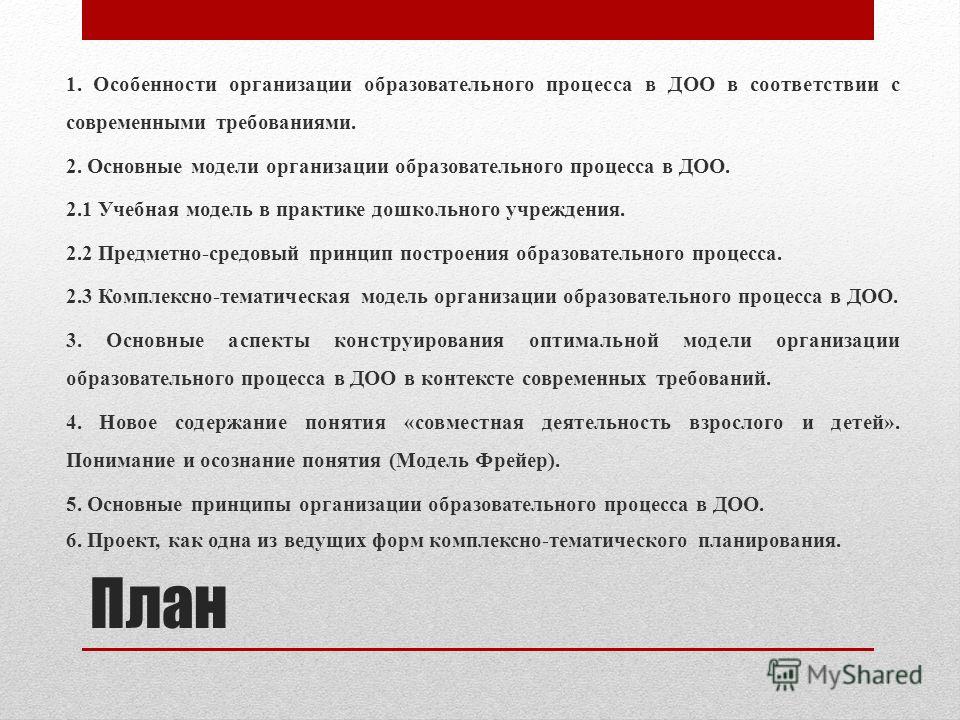
Features of the organization of the educational process in preschool educational institutions in accordance with modern requirements Approaches to the organization have changed educational process, which means the need to abandon the educational and disciplinary model with a clearly regulated structure of activities. The process of educational interaction with children today should include various forms: game, plot, integrated.
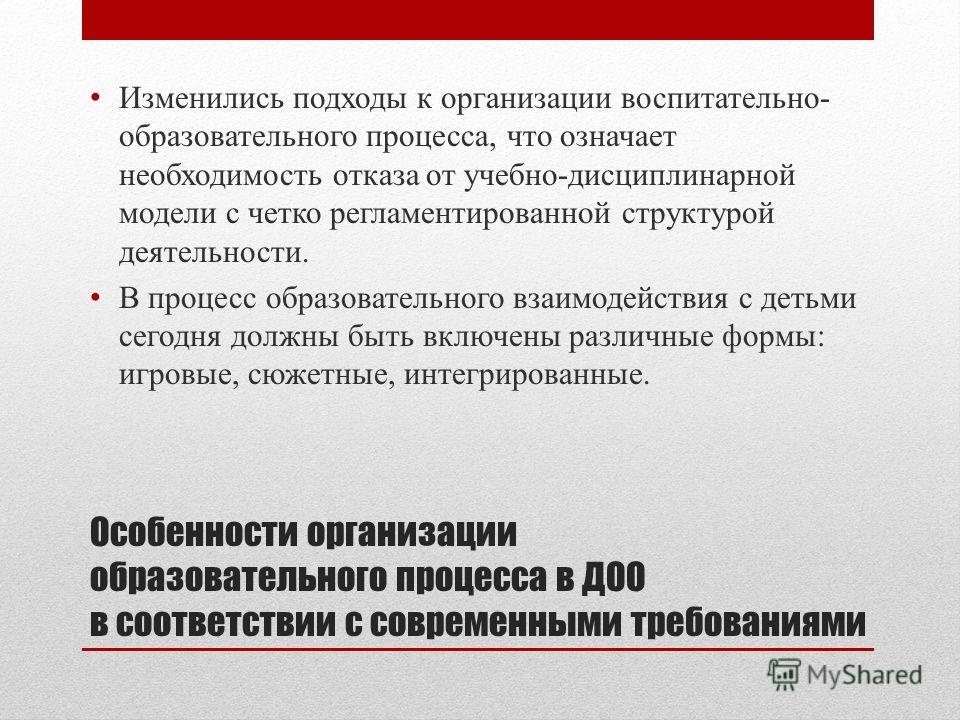
Direct educational activity This is an activity aimed at solving educational problems in the process of organizing various types of children's activities (game, motor, communicative, labor, cognitive and research, productive, musical and artistic, reading) and their integration using various forms and working methods.
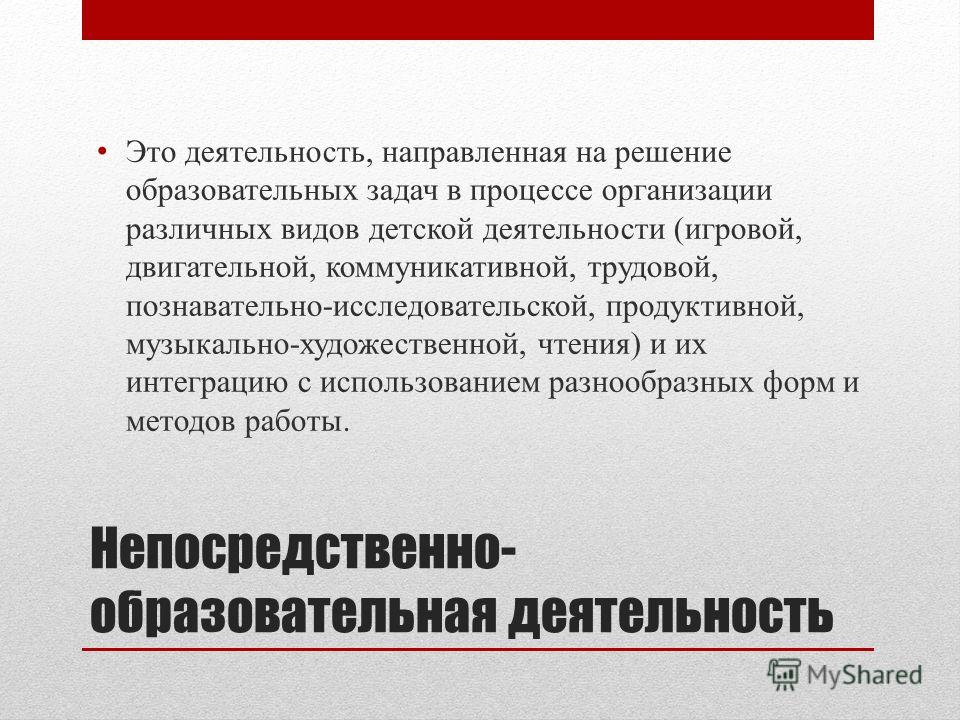
The fundamental difference between the term "occupation" and the term "directly educational activity" lies, first of all, in updating the structure and forms of organization of the entire educational process, in its individualization, and in changing the position of the teacher in relation to children. Aim directly educational activities, specially planned by the teacher, is the development of the integrative qualities of the child and the expansion of his knowledge about the world around him and the world of adults in the form of various games, excursions, project and productive activities, etc.

One of the main requirements is to build the educational process on age-appropriate forms of work with children. emphasis on joint activities of adults and children, on game forms education of preschoolers, for the lack of strict regulation of children's activities and makes the necessary changes to the content of the educational process of the preschool educational institution
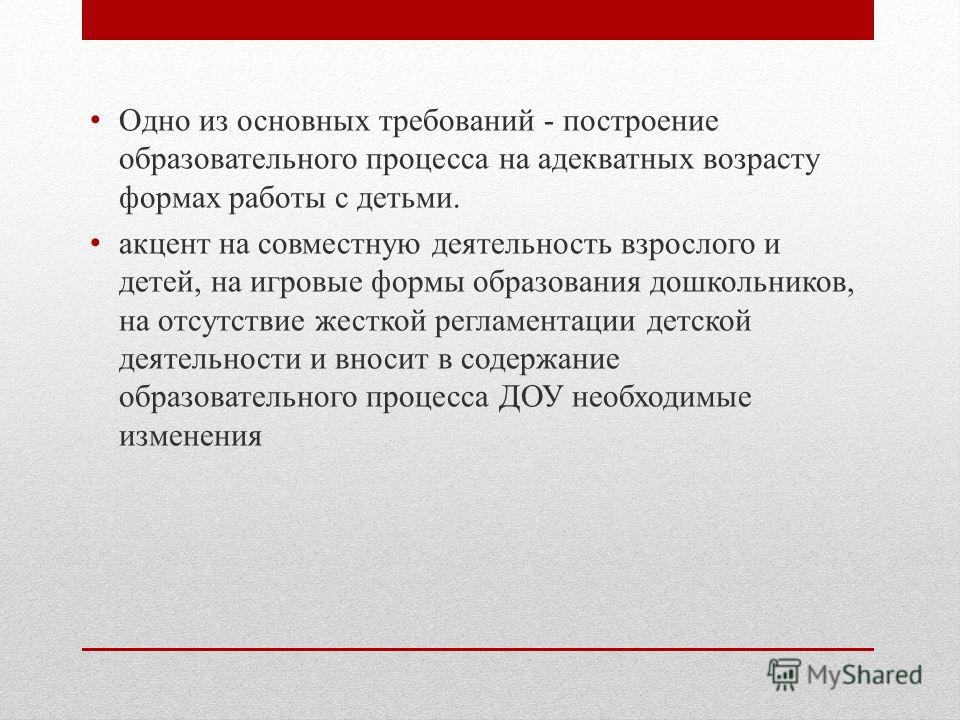

The main models of the organization of the educational process in pre-school education Educational model School-lesson form, disciplinary. The whole initiative belongs to the teacher, to help the educator - methods, notes, the content of which was not related to each other Complex-thematic model The theme is put in the basis, the implementation of the theme in different types activities. The creativity of the teacher is included. In general, the educational process was aimed at expanding ideas about the world around us, and not at development. Subject-environmental model The content of the educational process is directed to the subject environment (M. Montessori). Self-development of the child, but the educational process is lost.

Educational model or learning principle in the practice of ECE In this model, the adult's position is that of a teacher: the initiative and direction of activity entirely belong to him. The educational process is carried out in a disciplinary school lesson form. The attractiveness of the educational model for practitioners is determined by its high manufacturability, accessibility to a professionally trained teacher.
![]()
A common model for organizing the educational process before the introduction of FGT and GEF DO Independent activity of children Subject-developing and play environment (created by the educator) Joint activities of adults and children Regime moments in which the solution of the educational process is carried out (morning reception, walk, preparation for sleep, nutrition, etc.) Educational block The main form is a lesson (in accordance with the schedule of classes in which educational tasks were solved, formulated in integrated programs in sections - methods)

The structure of the construction of the training session The activities of the educator Organizing time and motivation of activity Transfer of information - presentation of educational (program) material Various ways of consolidating educational material Summing up the lesson, individual assessment Determining new goals The child's activity The emergence of interest Perception of the information transmitted by the teacher Understanding the information received The emergence of a sense of satisfaction The emergence of interest in the upcoming activity

Subject-environment model (or subject-environment principle) in practice preschool education In the subject-environment principle of building the educational process ( a prime example is the system of M. Montessori) the main component is the didactic material, the action with which, according to the authors, automatically develops the child, respectively, the adult is assigned a secondary role, mediated depending on the orientation of the didactic material.

A complex-thematic model of the organization of the educational process in a preschool educational institution The implementation of a theme in various types of children's activities (“living” by a child) forces an adult to choose a freer position than a teacher, bringing it closer to the position of a partner and employee. The complex-thematic model is fully consistent with age psychological characteristics children. At the same time, this model makes very high demands on the general culture, flexibility, creativity and intuition of an adult, without which this model simply will not work.
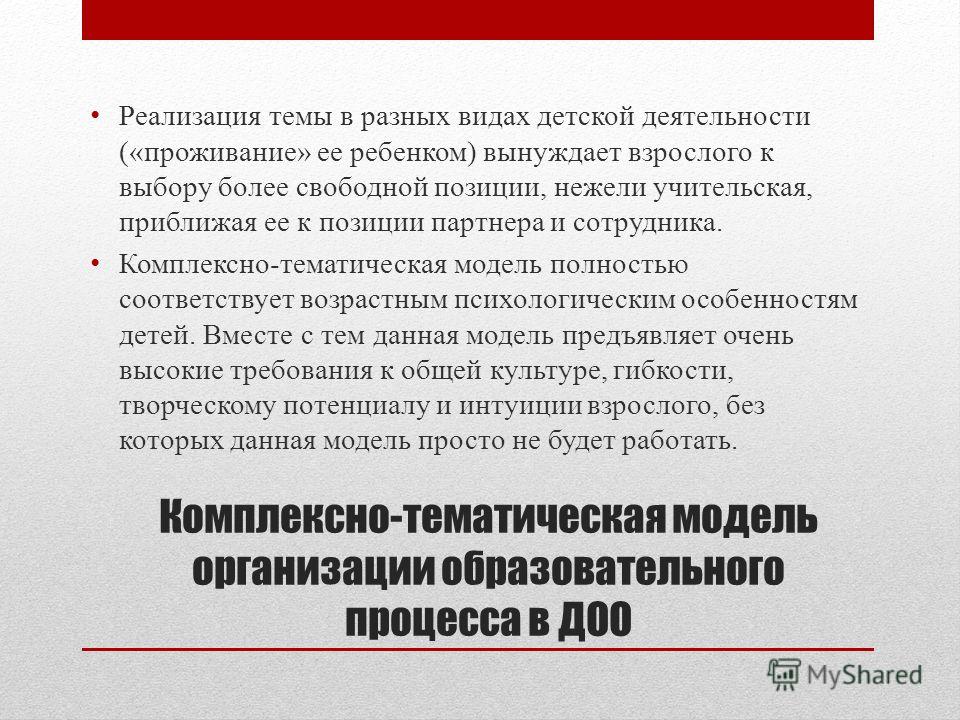

What should be the modern model of the educational process in a preschool educational institution? When designing an optimal model of the educational process for children preschool age it is necessary to keep in mind the features of the complex-thematic and subject-environment models and use them positive sides, and all this in combination with the “partnership” position of an adult, flexible selection of educational content and subject material.
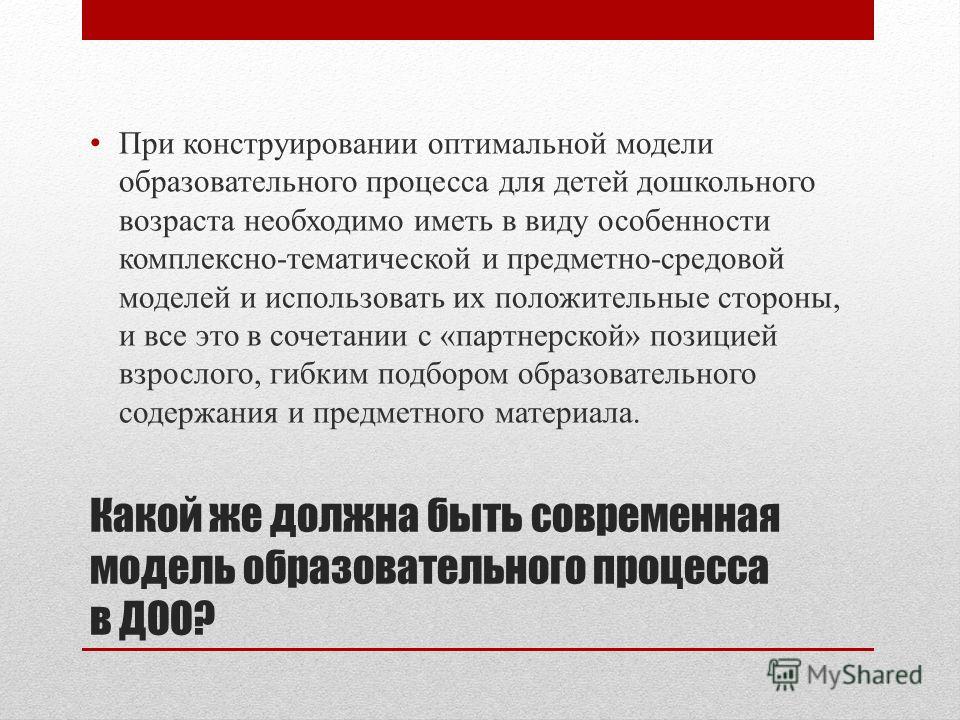


The main points of the organization of partner activities of an adult with children (according to N.A. Korotkova): The involvement of the educator in activities on an equal basis with children. Voluntary participation of children in activities. Free communication and movement of children during activities (with appropriate organization of the workspace). Open temporary end of educational activities.

Fundamental differences between the modern model of organization of the educational process and the "old" model: Exclusion of the educational block (but not the learning process!) Increase in the block joint activities of an adult and children Changing the scope and content of the concept of "directly educational activity" Changing the content of the concept of "joint activity of an adult and children" taking into account its essential (rather than formal) features
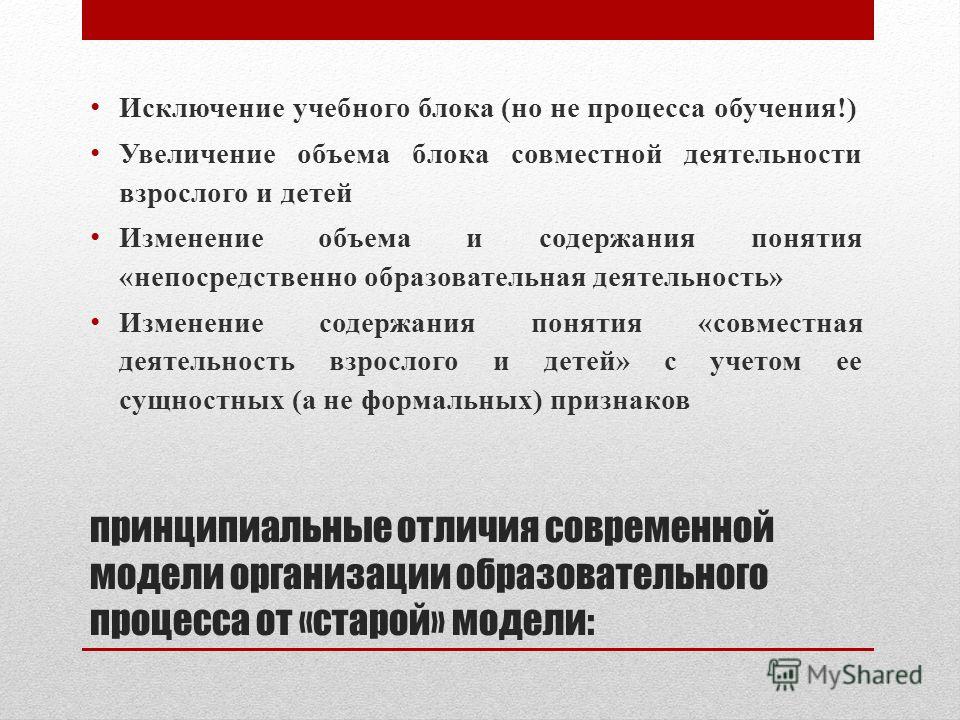

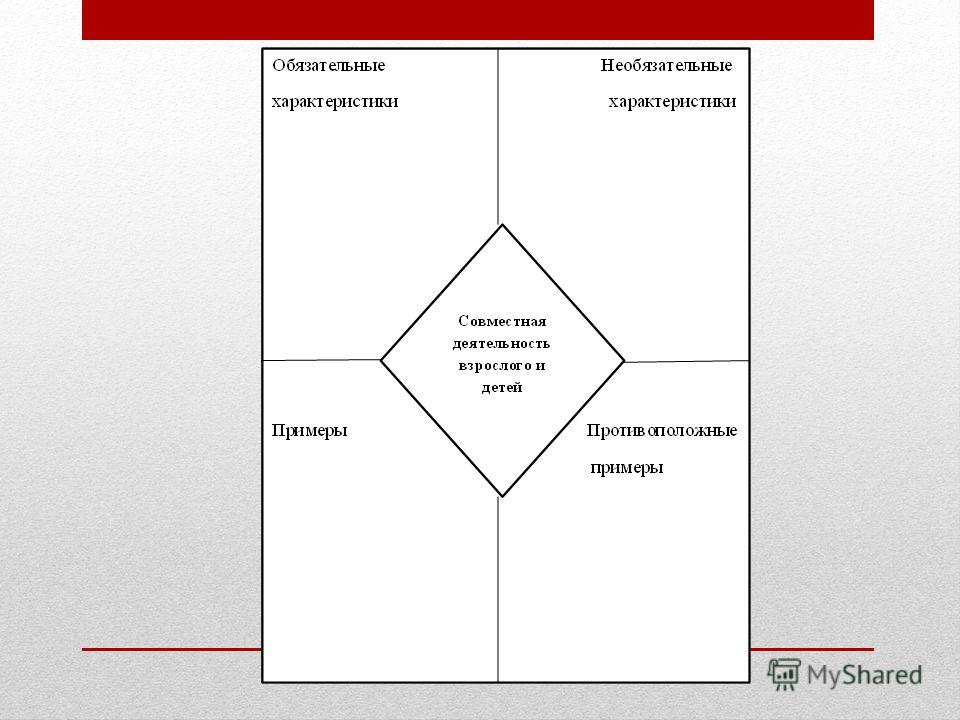
At the heart of the joint activity of an adult and children, after all, interaction, not influence. Another fundamental difference between joint activities and traditional activities is that in the classroom, first of all, knowledge, skills and abilities should be assimilated, and in the process of joint activity, the norms of interaction. The joint activity of the teacher and children is a developmental activity.
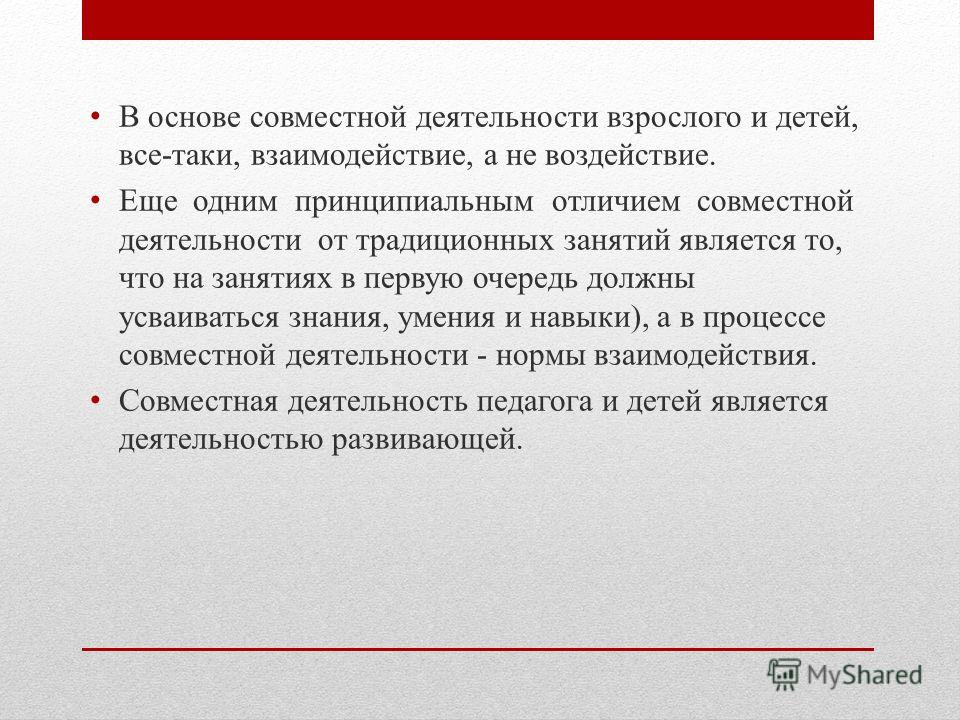
GEF DO Item III. Requirements for the conditions for the implementation of the main educational program preschool education. Clause 3.2. Requirements for the psychological and pedagogical conditions for the implementation of the main educational program of preschool education. Subparagraph For the successful implementation of the Program, the following psychological and pedagogical conditions must be provided:

Building educational activities based on the interaction of adults with children, focused on the interests and capabilities of each child and taking into account the social situation of his development; support by adults of a positive, friendly attitude of children to each other and the interaction of children with each other in various activities; support for the initiative and independence of children in activities specific to them; the opportunity for children to choose materials, types of activity, participants in joint activities and communication;

Item Conditions required to create social situation development of children, corresponding to the specifics of preschool age, suggest: ensuring emotional well-being support for the individuality and initiative of children establishing rules for interaction in different situations construction of a variable developmental education focused on the level of development, manifested in a child in joint activities with an adult and more experienced peers, but not actualized in his individual activities (hereinafter referred to as the zone of proximal development of each child) interaction with parents (legal representatives) on the child's education , their direct involvement in educational activities

Model for organizing joint activities Activities of the educator Creating a problem situation Joint identification of significant problems, putting forward hypotheses for their solution Coordination of independent search Joint discussion of the results Independent search Activity of the child Emergence of the “I want” state
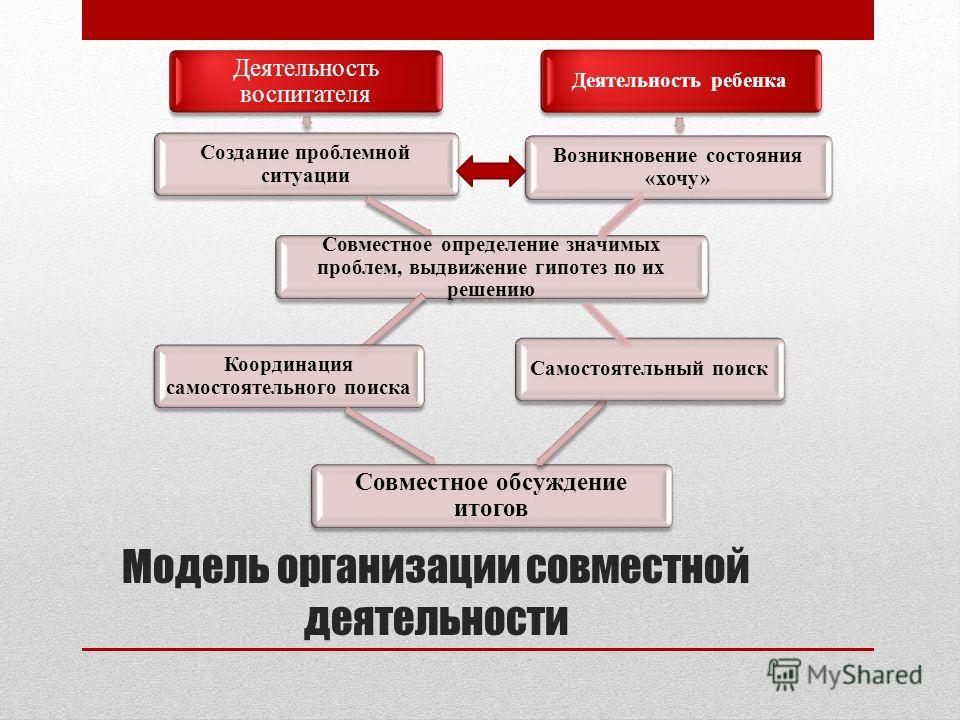
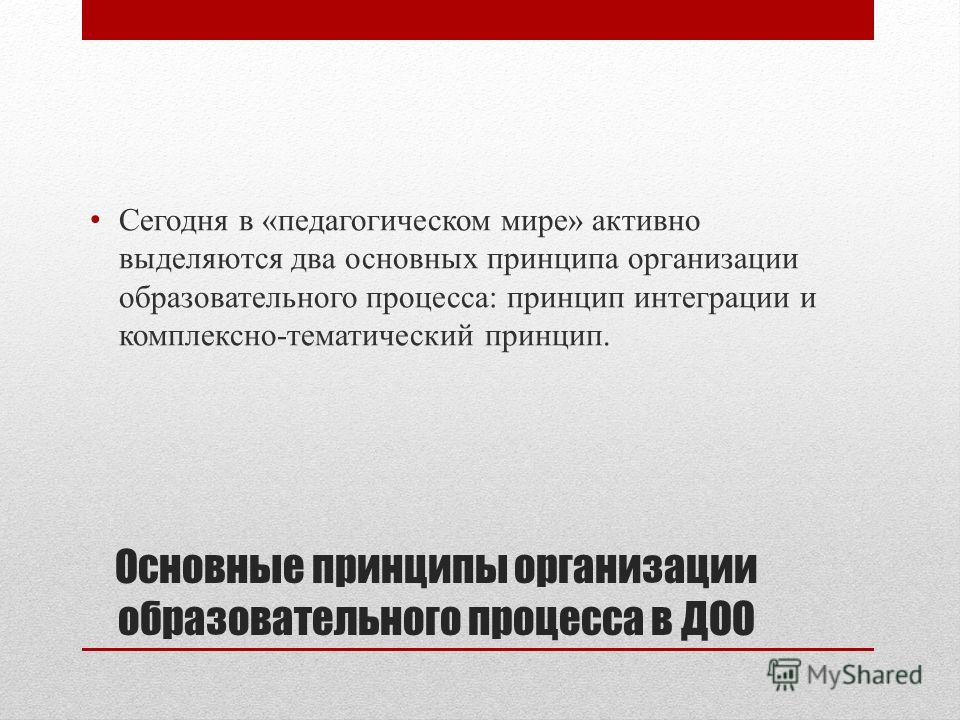
In accordance with the complex-thematic principle of constructing the educational process, it is proposed to motivate educational activities not a set of individual playing tricks, but a cycle of any topics, plots, projects or events that are significant and interesting for preschoolers, around which educational activities are “built”.
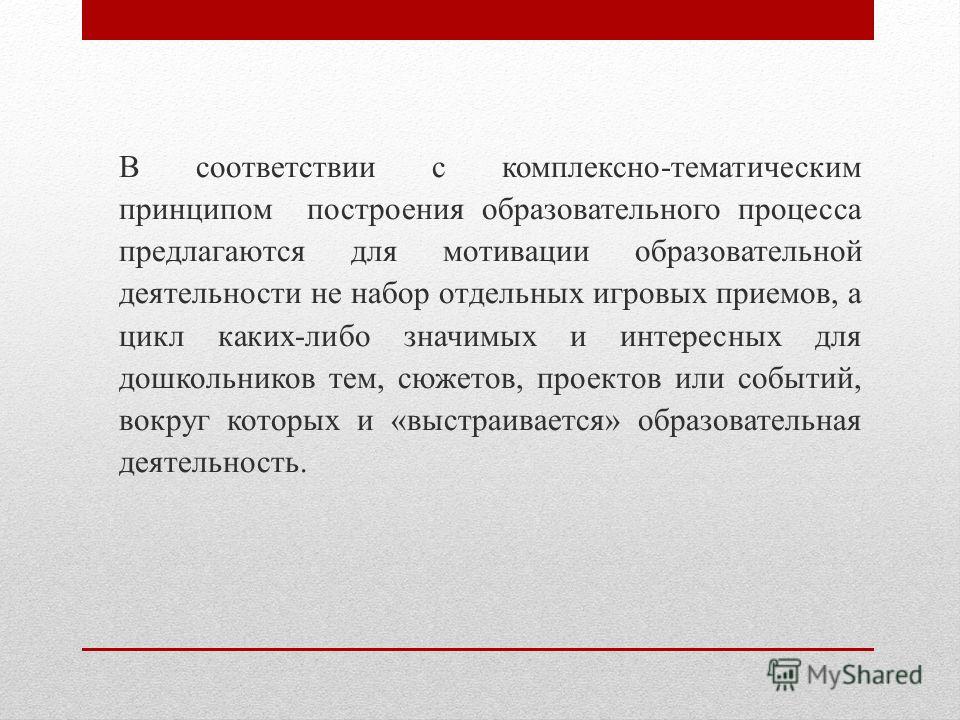
Integration is the combination of knowledge from different educational fields to solve one problem in various types and forms of joint activity. At the same time, knowledge should complement, enrich each other in solving didactic problems. The specificity of integration is associated with its implementation within the framework of the educational process in kindergarten and combining tasks from different "educational areas".
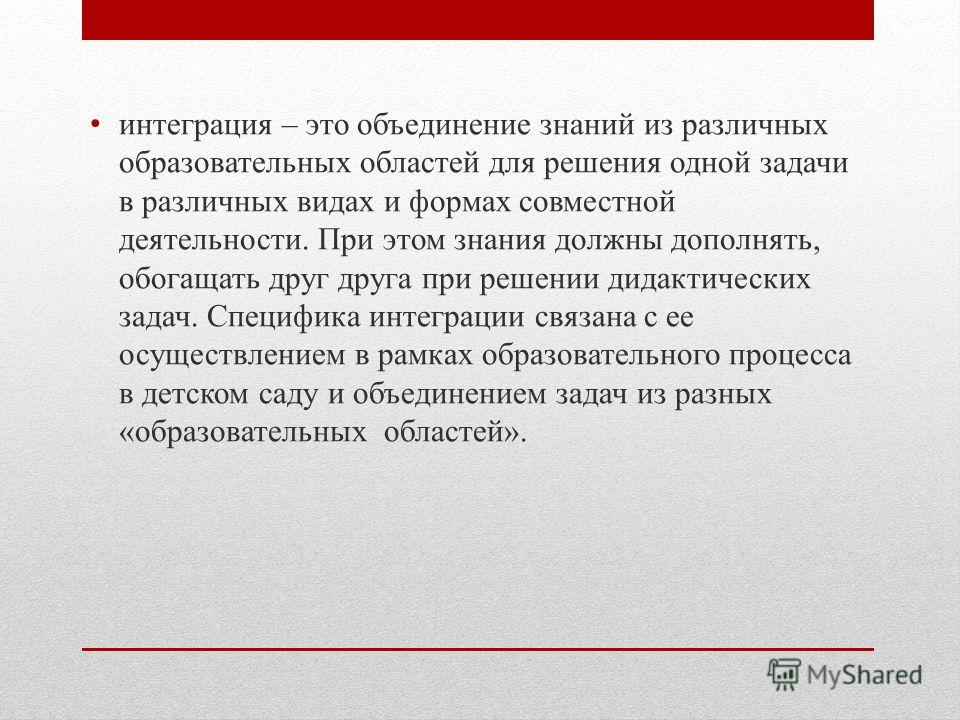
In an adult, the following changes: the style of an adult's behavior: from administrative-regulatory to relaxed-confiding; a workspace where collaboration takes place: from a separate place at the "teacher's" table to a place at a common table next to the children; the attitude of the teacher to the performance of common work: from general guidance to participation in the performance of a certain part of the work, etc.
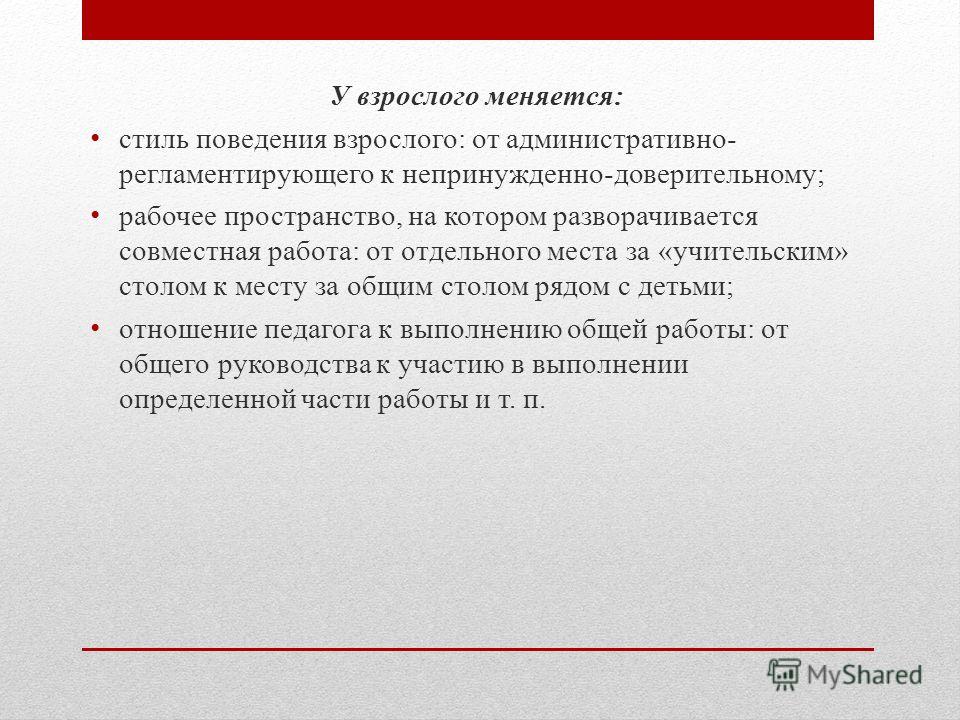
The child has the opportunity to: Choice - to participate in this work or to organize something else, to do something else. Children can decide for themselves whether or not to participate in the common work. But this is not the introduction of permissiveness and anarchy. It is the freedom to choose between activities and their content, and not between activities and doing nothing. The order and organization of joint activities are being developed: free placement of children at a common table, their communication with other children in the course of work and movement as necessary. In the course of work, children can contact the teacher, approach him, discuss with him questions of interest to them, etc. Children can work at different paces. Each child can determine the amount of work for himself: what he will do, but he will do it well and bring the work he has started to the end. Children who have finished work earlier can do what interests them. In the event that the child did not cope with the work, he can continue it in the following days.

The project as one of the leading forms of integrated thematic planning The first indicator of the project is the availability common theme. When formulating the topic of the project, it is necessary to follow the principles of problematicness, accessibility, attractiveness and personal significance of the topic for children, generalization and content, depending on the age of the pupils. goal setting project activities possible through the definition of the final product of the project. The final product of the project, if possible, should have a material embodiment. The teacher's choice of the form of organizing children depends on the content of the activity, the capabilities of the children and the pedagogical tasks. The project is effective tool involvement of parents in the educational activities of a preschool institution.
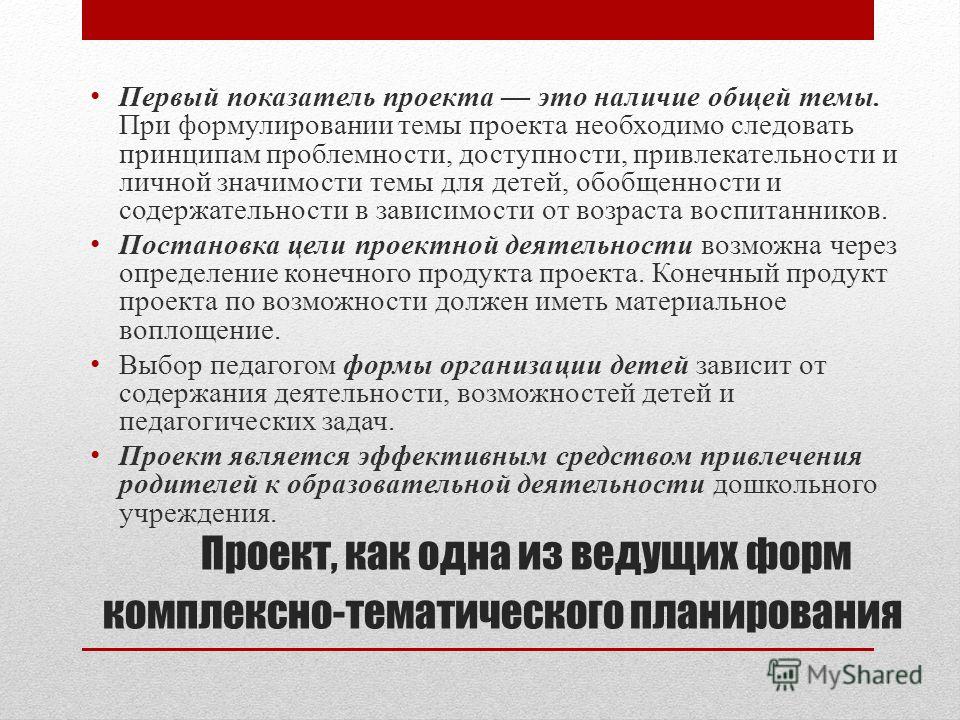
ELEMENTS OF THE SYSTEM OF NATURAL SCIENTIFIC KNOWLEDGE
Plan for the study of scientific facts
(data of observations and experiments)
1. Specify by whom and when the experiment was carried out, what was its purpose.
2. Determine the means by which the experiment was set up (devices and materials), study the schematic diagram of the installation.
3. Understand the procedure for conducting the experiment.
4. Find out the main results of the experiment.
5. Get acquainted with the content of the explanation of the experimental data from the standpoint of modern scientific knowledge (laws, theories).
Plan for studying a physical phenomenon (object)
1. Signs of the object, the conditions for its existence. Object types. Methods of reproduction in the laboratory.
2. Properties of the object and the values that characterize them.
3. The relationship of the properties of the object, its mathematical expression.
4. Dependence of object properties on external factors, mathematical expression of this dependence.
5. The nature of the object (theoretical model), explanation of its main properties from the standpoint of modern scientific knowledge (laws, theories).
6. Using the properties of the object in practice.
7. Ways to prevent or protect against unwanted manifestations of the properties of the object.
Plan for studying a physical phenomenon
(process - movement, interaction)
1. Signs of the phenomenon, the conditions for its occurrence (definition of the phenomenon).
2. Examples of manifestation in living and inanimate nature. Varieties of the phenomenon. Methods of reproduction in laboratory conditions.
3. Quantitative characteristics of the phenomenon.
4. Dependence of the nature of the occurrence of the phenomenon on external factors.
5. The laws that the phenomenon obeys, their mathematical expression.
8. The essence of the phenomenon, the mechanism of its course (an explanation of the phenomenon from the standpoint of modern scientific knowledge - laws, theories).
6. Use of the phenomenon in practice.
7. Ways to prevent or protect against the nature of the phenomenon that is harmful to humans.
Plan for studying a physical quantity
(quantitative characteristics of the phenomenon)
1. What physical phenomenon characterizes this quantity (namely: property what material object characteristic what movement or interaction it reflects).
2. Definition of a given physical quantity, its defining formula.
3. What is this value ( vector, scalar)?
4. Units of measurement of this value: basic, additional. Determination of the basic unit of measurement of a physical quantity. The ratio between units of measure.
5. Relationship of a given quantity with other quantities, mathematical formulas expressing this relationship (except for the defining formula).
6. Methods for determining the value: direct, indirect. The essence of the methods, instruments necessary to perform measurements.
Physical Law Study Plan
1. The name of the scientist who established the law; his short biography.
2. The wording of the law.
3. Mathematical expression of the law (the relationship between which quantities this law expresses, the type of relationship - direct proportionality, inverse proportionality and so on.).
4. Experiments confirming the validity of the law (description of the experimental setup, procedure for conducting the experiment, its main results).
5. Limits of applicability of the law.
6. Explanation of the law from the position of modern scientific knowledge (laws, theories).
7. Ways of practical use (accounting) of the law.
Physical Theory Study Plan
1. Basis of the theory:
· experimental basis: scientific facts (experimental data) that served as the basis for the development of the theory;
· general scientific basis: pre-existing theories, general scientific and natural science principles on the basis of which the theory was built;
· theoretical background: idealized object of the theory (model), its characteristics; principles and postulates of the theory.
2. The core of the theory is a system of equations of the theory describing the behavior of an idealized object.
3. Consequences of the theory:
a range of scientific facts, experimental laws explained by this theory,
scientific facts, experimental laws predicted by theory,
less general theories included in this theory as its constituent parts.
4. The limits of applicability of the theory (the range of phenomena that the theory does not explain, as well as phenomena to which it gives only a qualitative interpretation).
Physical picture of the world (PKM)
1. The subject of physics as a science of nature.
2. The concept of matter and forms of its existence (substance and field):
· structural forms of material organization of matter, its multilevel nature: microparticles, macro- and metasystems;
· the field form of the existence of matter (the field as a "carrier" of interaction and the basis of the existence of material systems, varieties of the field form of matter);
· interaction of matter and field, their mutual transformations (particle-wave dualism).
3. Movement as an attribute of matter. Forms of motion of matter. Space and time as forms of existence of matter. The unity of matter, motion, space and time.
4. Energy resource of matter in its real and field form. Energy as a universal measure of the motion of matter.
5. Fundamental principles in physical science as the most general laws of the existence of the material world.
6. Methods of cognition and the structure of scientific knowledge in physical science. Physical theory in the hierarchy of scientific knowledge. The structure of physical theory.
8. Fundamental physical theories as models reflecting the essence with some degree of approximation and explaining the patterns of behavior of various material systems. The principle of correspondence in the development of theoretical knowledge in the field of physical science.
9. Evolution of the physical picture of the world.
10. Contemporary Issues physical science. Scientific hypotheses, as theories that have not received their own experimental confirmation. Prospects for the development of physics.
11. Applied orientation of physical science, its humanitarian significance.
Natural Science Picture of the World (ENKM)
1. The system of natural sciences and their subject areas.
2. Matter and forms of its existence. Structural forms of matter. inanimate and Live nature in the system of forms of the structural organization of matter. Substance and its species diversity. Life forms.
3. Evolutionary processes in animate and inanimate nature, patterns of these processes. The unity of animate and inanimate nature (relationship, interaction, interdependence).
4. Principles of natural science as the most general approaches to the study of the behavior of material systems in animate and inanimate nature.
5. A system of fundamental natural-science theories that explain the patterns of phenomena in animate and inanimate nature, allowing you to control these phenomena, predict their development trends.
6. Interaction of natural sciences, synthesis of scientific views of various subject areas. Methods of natural science knowledge (general, special). Interaction of special methodology of knowledge in frontier scientific disciplines.
7. ENKM evolution, the role of individual natural sciences in the formation of scientific views on the nature of being and consciousness. The structure of natural science knowledge.
8. Modern natural science paradigm. The humanitarian component of the ENKM. Problems of man as a physical and biological system. Problems of life support of societies and preservation of human civilization.
9. Successes and prospects for the development of natural sciences, their most significant practical applications.
Modern painting of the world (SNK)
1. The world and its components. The unity of nature, man and society. Human mission.
2. Nature, man, society as objects of knowledge. Culture as a process and result of world exploration.
3. Spheres of development of the world: science, art, morality. Components of culture: physical, spiritual, social.
4. The modern picture of the world as a reflection of the fundamental, most significant part of human culture.
5. Science as a component of the spiritual culture of society. Hierarchy of sciences and their subject areas.
6. Scientific picture of the world as a synthesis of the fundamental components of the sciences of nature, man and society.
7. Philosophy - the science of the most general laws of being and consciousness.
8. The evolution of philosophical views on the essence of being and consciousness, its relationship with the evolution of natural science views and the development of the technological culture of society.
9. Humanitarian mission of science.
10. Art and its main areas. Ethnocultural heritage in art. Evolutionary processes in art. Modern facets of art.
11. Morality. The moral culture of society and its components. National elements in moral culture and universal values. The evolution of moral culture, its relationship with the development of science and technological progress. Law as a way to protect the moral culture of society, preserve its valuable traditions and stimulate progressive development trends.
12. Religion as a component of the spiritual culture of society. Worldview: scientific, religious. Science and religion at various historical stages in the development of nature and society. Religions of the world and their interaction.
13. Modern political culture of society. Historical plan for the development of political culture.
14. Processes of interaction in the spiritual and social spheres: science and art; science and morality; art and morality; politics and morality; science and politics; art and politics.
15. Physical Culture person and society. Healthy lifestyle.
16. Ways of storage and transmission of cultural heritage in human civilization. Education. Information educational systems. Man in macro educational space. Information culture of modern society.
17. Choice and self-determination. Human culture as a component of universal human culture.
Plan for the study of a physical device
(technical installation)
1. Purpose of the device.
2. The main parts of the device and their purpose.
3. The principle of operation of the device (what phenomena, the laws of their course are the basis for the operation of the device; the interaction of the main elements in its device, the sequence physical processes defining this interaction).
4. Rules for using the instrument (and measurement rules for measuring instruments). Safety precautions in working with the device.
5. Scope of the device.
6. Varieties of the device and areas of their application.
Process study plan
1. Purpose of the technological process.
2. Schematic diagram of the process: characteristic of the instrumental technological system(the main parts of the technological installation: tools, machines, devices); main stages of the technological process.
3. Phenomena and laws of their course, which form the basis of the technological processing of objects at each stage of the technological process.
4. Economic importance of technology.
5. Problems of ecological safety of the technological process. Ways to solve them by means of physical science.
GENERALIZED MODELS OF LEARNING ACTIVITY
Plan for the preparation and conduct of a physical experiment
1. Formulate (understand) the research problem.
2. Put forward and justify a hypothesis, on the basis of which the formulated problem can be solved.
3. Determine the purpose of the experiment.
4. Develop a project for an experimental setup, design it.
5. Determine the order of the experiment.
6. Choose a method for coding the data of the experiment (observations, measurements).
7. Conduct an experiment, perform the necessary observations and measurements.
8. Process the measurement results, evaluate their accuracy.
9. Analyze and interpret the obtained results, formulate a conclusion.
Measurement action plan
1. Determine the division value of the device.
2. Check the upper and lower measurement limits.
3. Prepare the instrument for operation in accordance with the instructions for use.
4. Carry out the measurement (during the measurement, it is necessary to eliminate the parallax error).
absolute measurement error,
Relative measurement error.
6. Write down the measurement result, taking into account the error.
Action plan for systematization of scientific facts
(empirical classification of experimental data)
1. Determine (understand) the object of classification (which phenomena studied in the experiment are subject to classification).
2. Select the signs of phenomena, compare phenomena, i.e. establish similarities and differences in their features.
3. Group phenomena according to common and essential features.
4. Check the validity of the constructed classification.
5. Present the classification results in a visual form.
Plan of activity for generalization of scientific facts
(identifying empirical patterns)
1) establish that object X has feature A, object X has feature A, and object X has feature A;
2) to abstract the identification of objects X, X, X and all other possible objects X according to their common features (other features are not taken into account), that is, to identify a class of objects that have a certain set of the same features;
3) to extrapolate the knowledge about the feature A, obtained from the direct study of objects X , X , X , to all other objects X of this class.
Plan for explaining and predicting natural phenomena
based on empirical laws (solution of physical problems)
2. Perform an analysis of the condition of the problem.
3. Briefly write down the condition of the problem.
4. Determine the physical law (laws), with the help of which it is possible to explain or predict the phenomenon described in the problem, the value of the quantities that characterize it.
5. To prove that this phenomenon or the desired value of the quantity characterizing it is a consequence of the specified physical law (laws), for this:
write down the mathematical expression of the law (laws);
Perform an analysis of these mathematical expressions, that is, to establish whether all the physical quantities included in the equations are presented in the condition of the problem (if necessary, enter additional equations);
solve the system of equations in general view, get a mathematical expression for the desired value;
Perform calculations in SI.
6. Check the solution of the problem in one of the ways.
Plan of activities during the
scientific and technical research (invention, rationalization)
1. Formulate (understand) the content of the technical problem.
2. Determine which phenomenon (phenomena), the regularity of its course can be taken as the basis for its solution.
3. Find a fundamental idea for solving a technical problem (that is, determine how the desired practical effect can be obtained when using this phenomenon).
4. Develop a project of a technical installation (determine its main parts, their technical design, sequence and methods of their interaction).
5. Consider ways to prevent possible undesirable effects associated with the occurrence of phenomena on the basis of which the design and operation of a technical installation is built. Design appropriate protective equipment.
6. Create a prototype model of a technical installation.
7. Check the prototype model in action, eliminate the detected shortcomings in its work.
8. Make a model of the technical installation.
9. Write a guide to its practical use.
Plan for analysis of the graph of functional dependence
1. Clarify the relationship between which quantities is shown on the graph.
2. Pay attention to the units of measurement of these quantities and their scale along the coordinate axes.
3. By an arbitrary value of the argument, determine the value of the function, and vice versa.
4. By an arbitrary change in the value of the argument, determine the change in the values of functions, and vice versa.
5. Determine the type of dependence (direct proportionality, power law, etc.). Write down, using the graph, the equation of functional dependence.
6. Using the process graph, determine all possible quantitative characteristics of it.
Statistical table analysis plan
1. Read the title of the table, indicate the conditions under which the numerical data entered into it were recorded.
2. Read the headings of the columns of the table, understand their meaning, pay attention to the units of physical quantities.
3. Find out which of the objects (processes) indicated in the table has the largest (smallest) value of the value specified in the table.
4. Find the value of the given value for any of the objects (processes), understand its physical meaning.
Feature Table Analysis Plan
1. Explain the purpose of the table, determine the conditions under which the numerical data entered into it were recorded.
2. Read the table column headings, understand the meaning, pay attention to the units of physical quantities.
3. Find out which of the values presented in the table is an argument ( independent variable), and which one is a function ( dependent variable).
4. Specify the "step" of changing the argument values.
5. Try, comparing the change in the values of the argument with the change in the values of the function, to determine the type of functional dependence. If this cannot be done from the analysis of the table, build a graph based on the data in the table and find out the type of dependence using it.
6. Specify which characteristics of the process specified using this table of functions can be determined based on its numerical analysis.
Generalized work plan
- Protons and neutrons: pandemonium inside matter
- Majestic Antarctica - the keeper of secrets
- Majestic Antarctica - the keeper of secrets
- Eternal Rajputi. Who are the Rajputs
- Electric Discharge Definition
- Wives of the Sultan of Brunei life in the royal palace
- Why the Sultan of Brunei got rid of the "extra" wives

 Live Journal
Live Journal Facebook
Facebook Twitter
Twitter